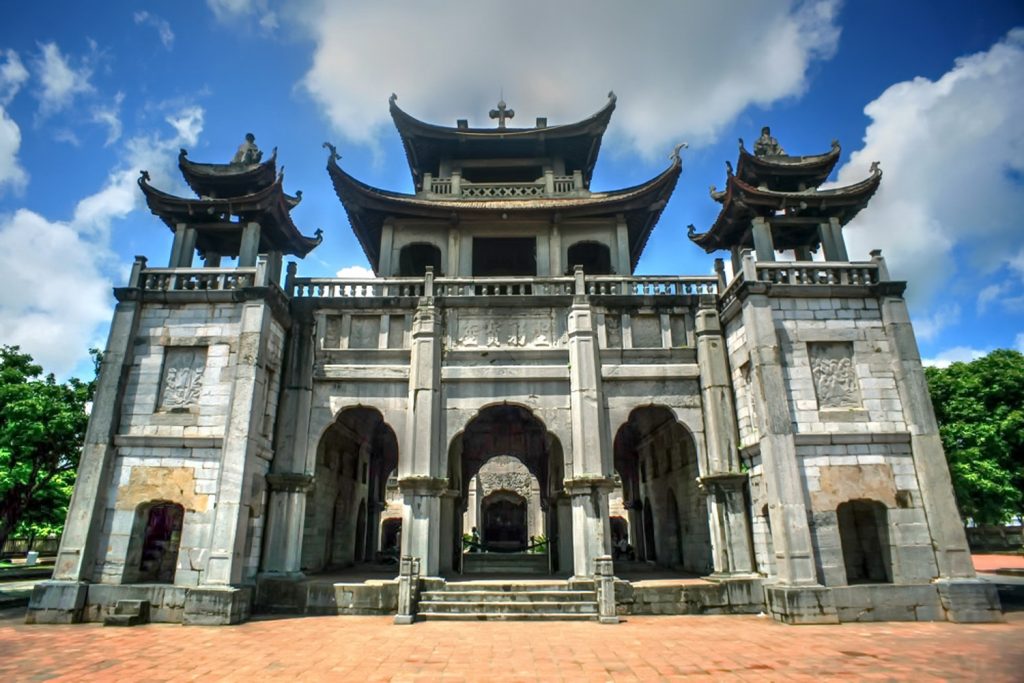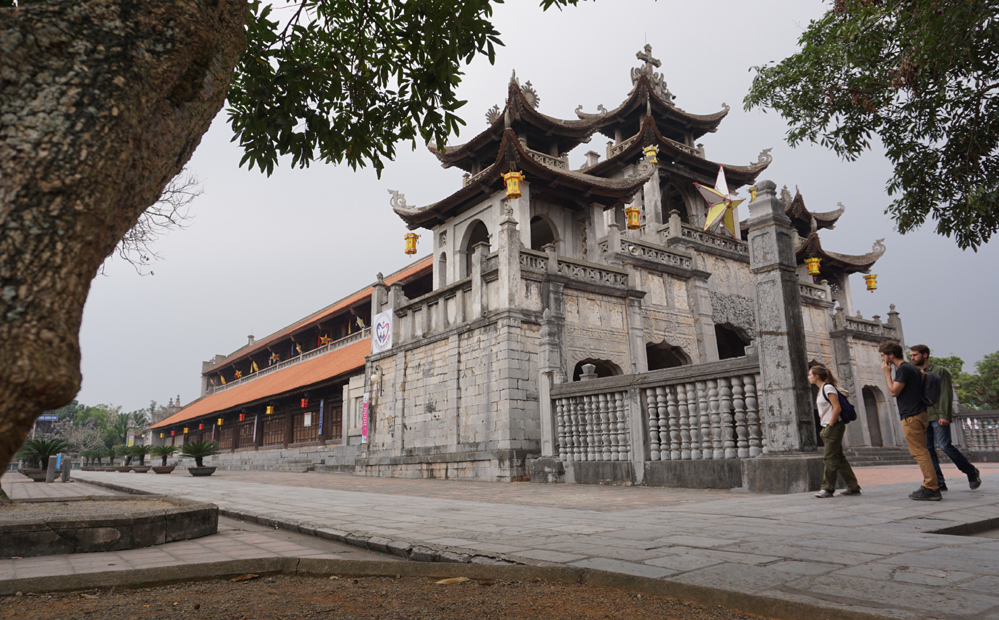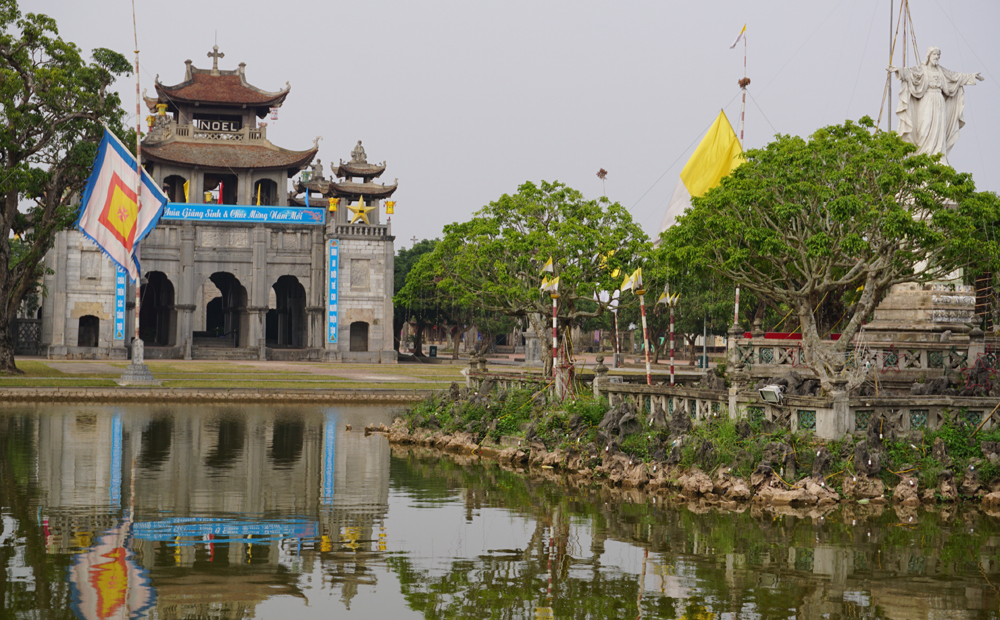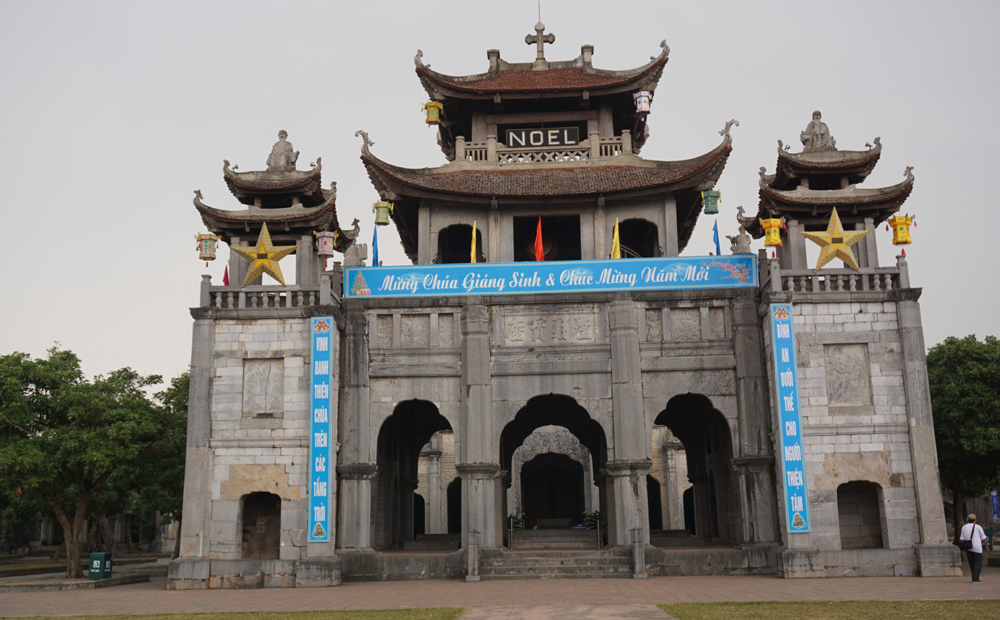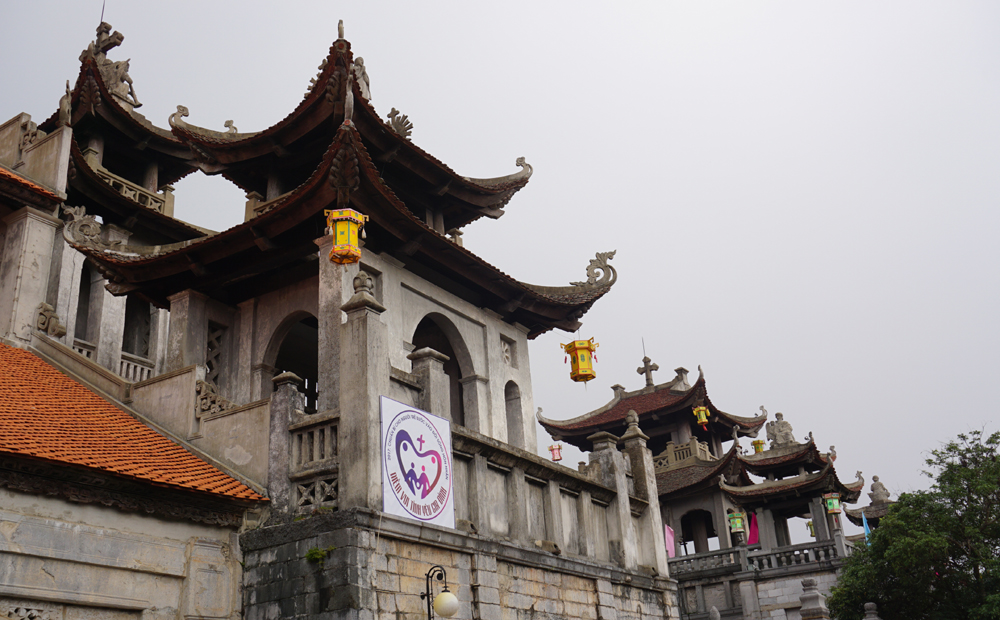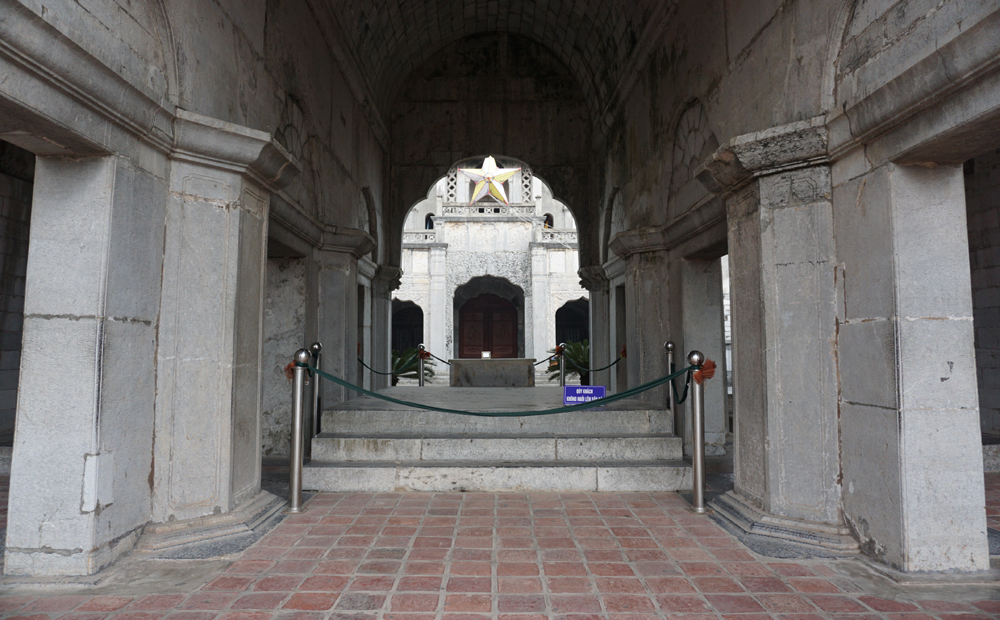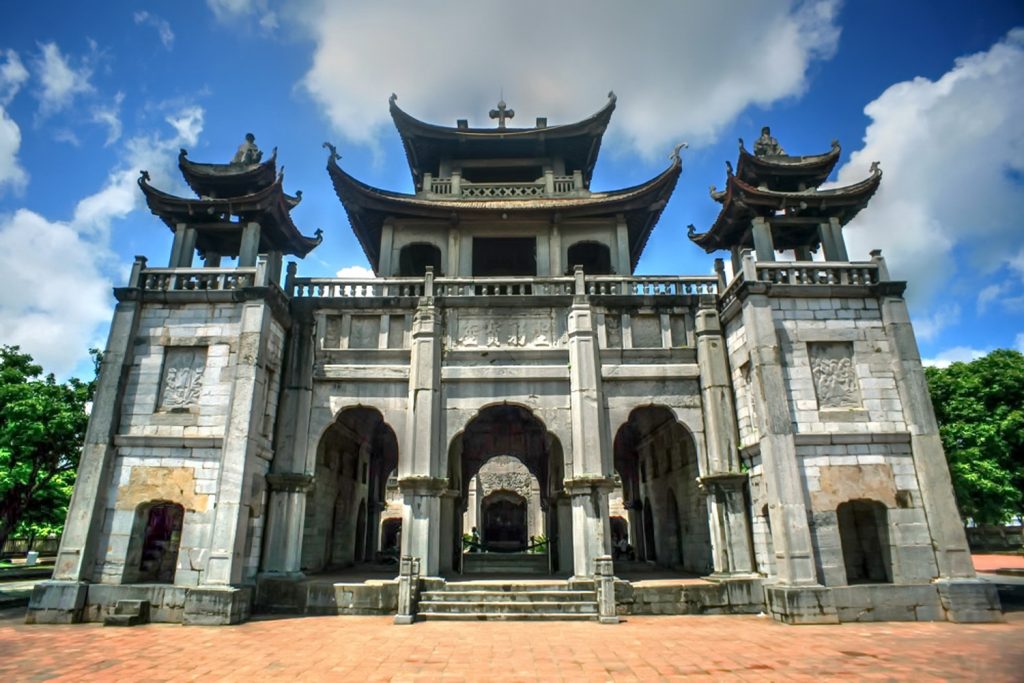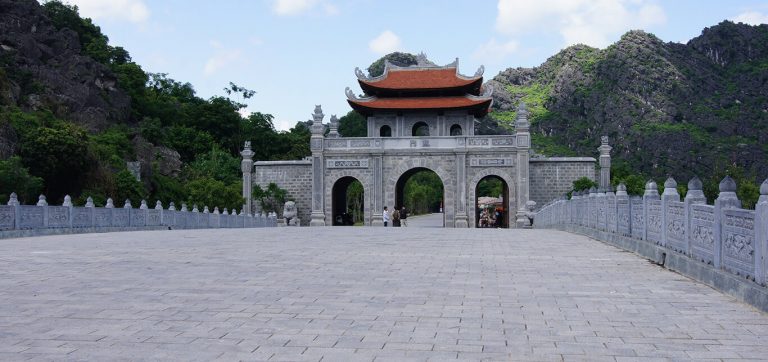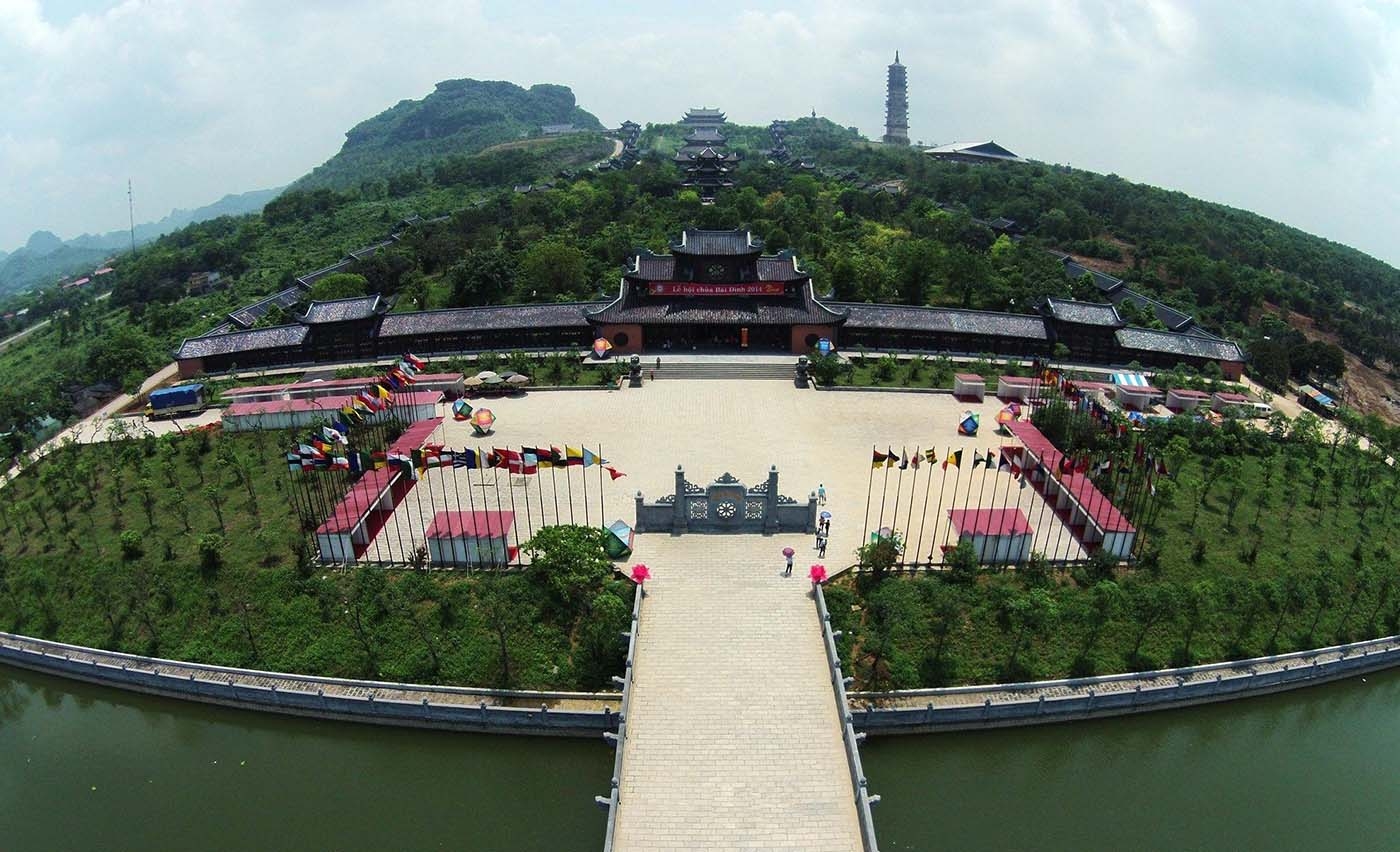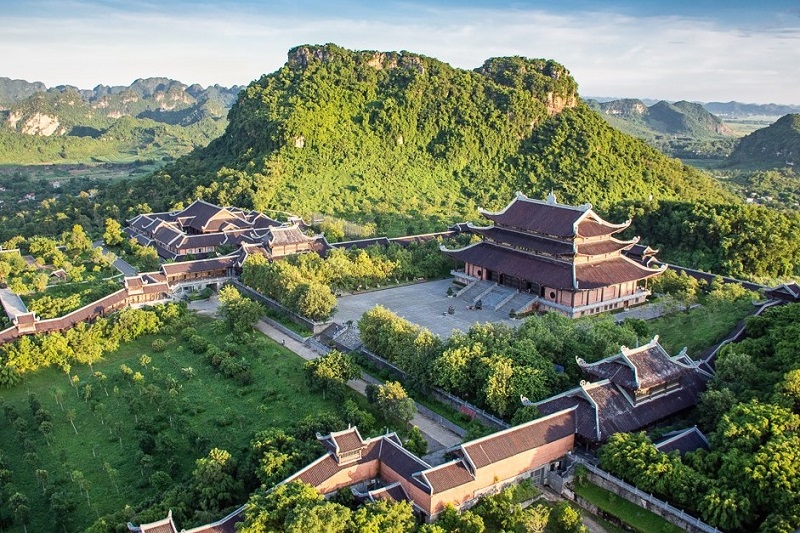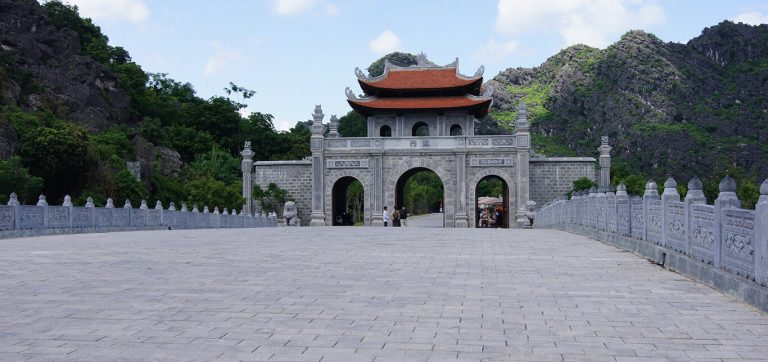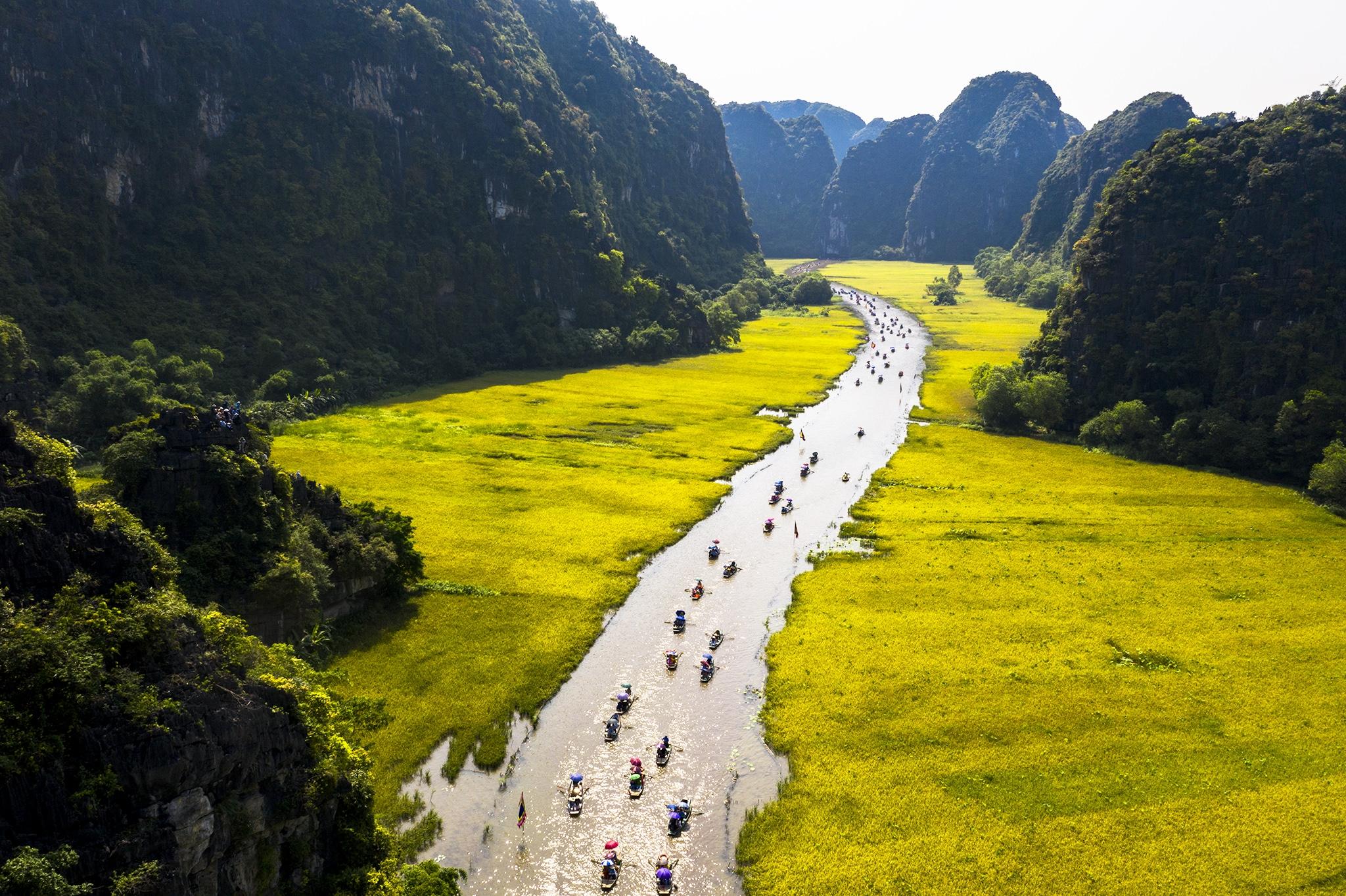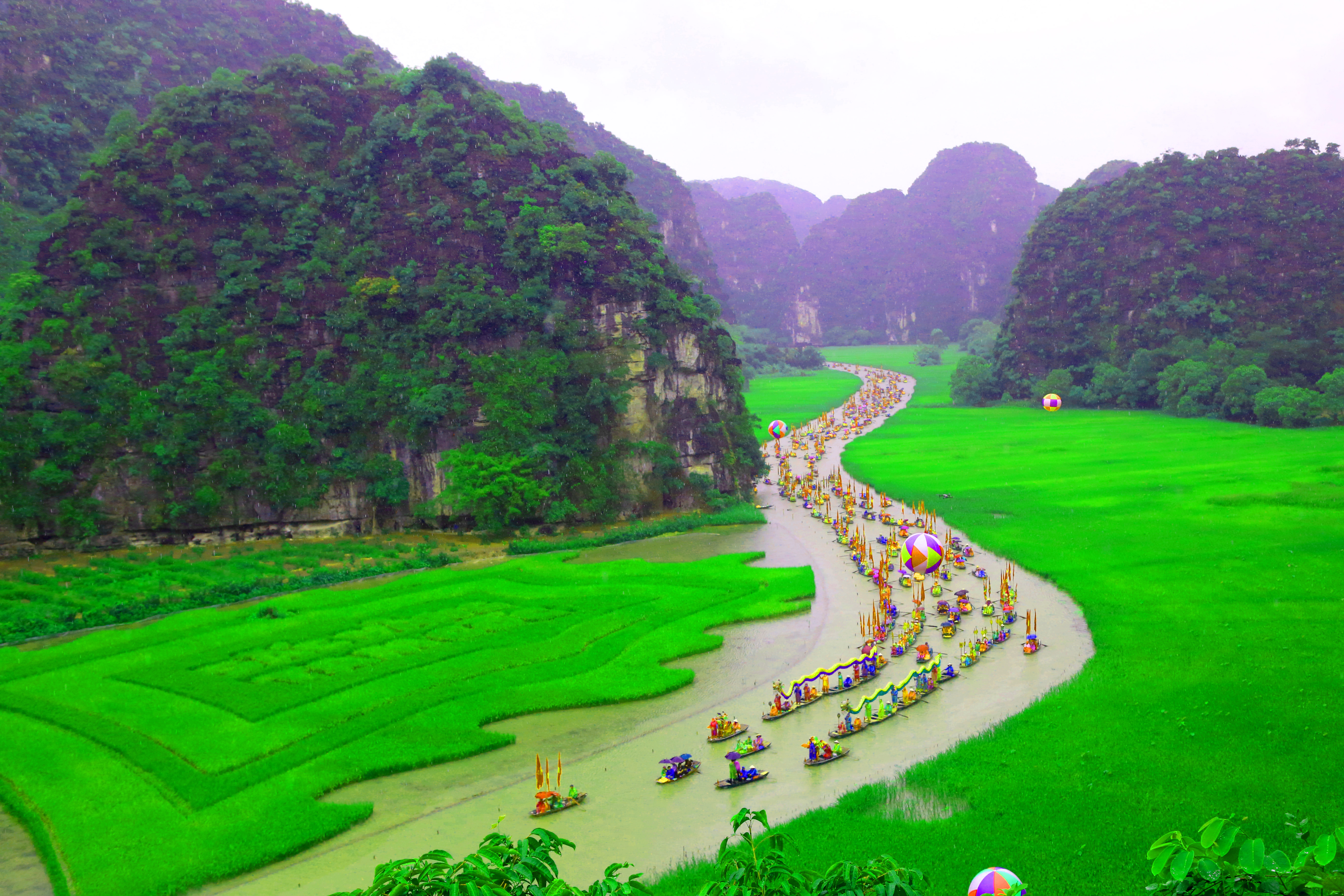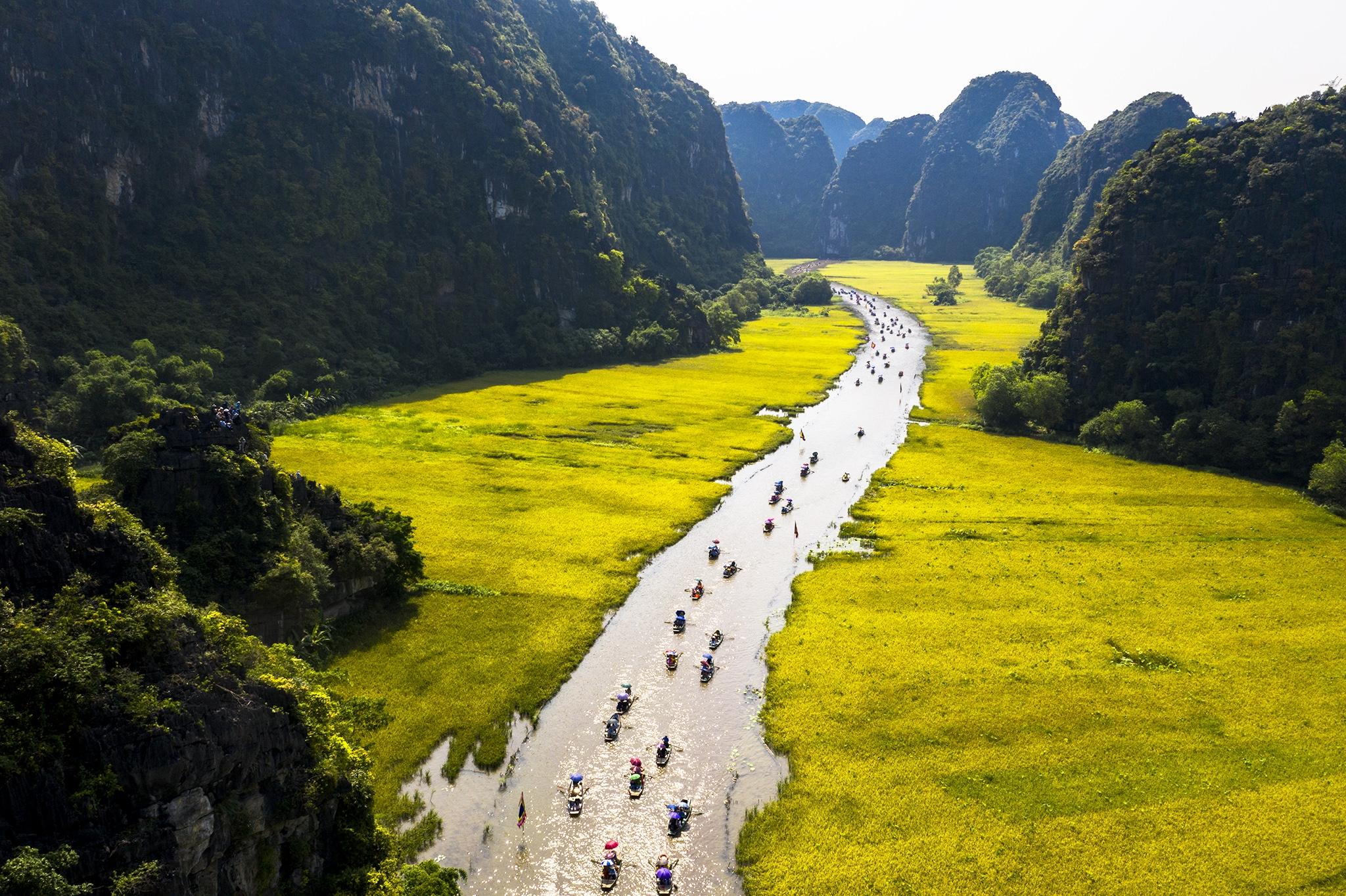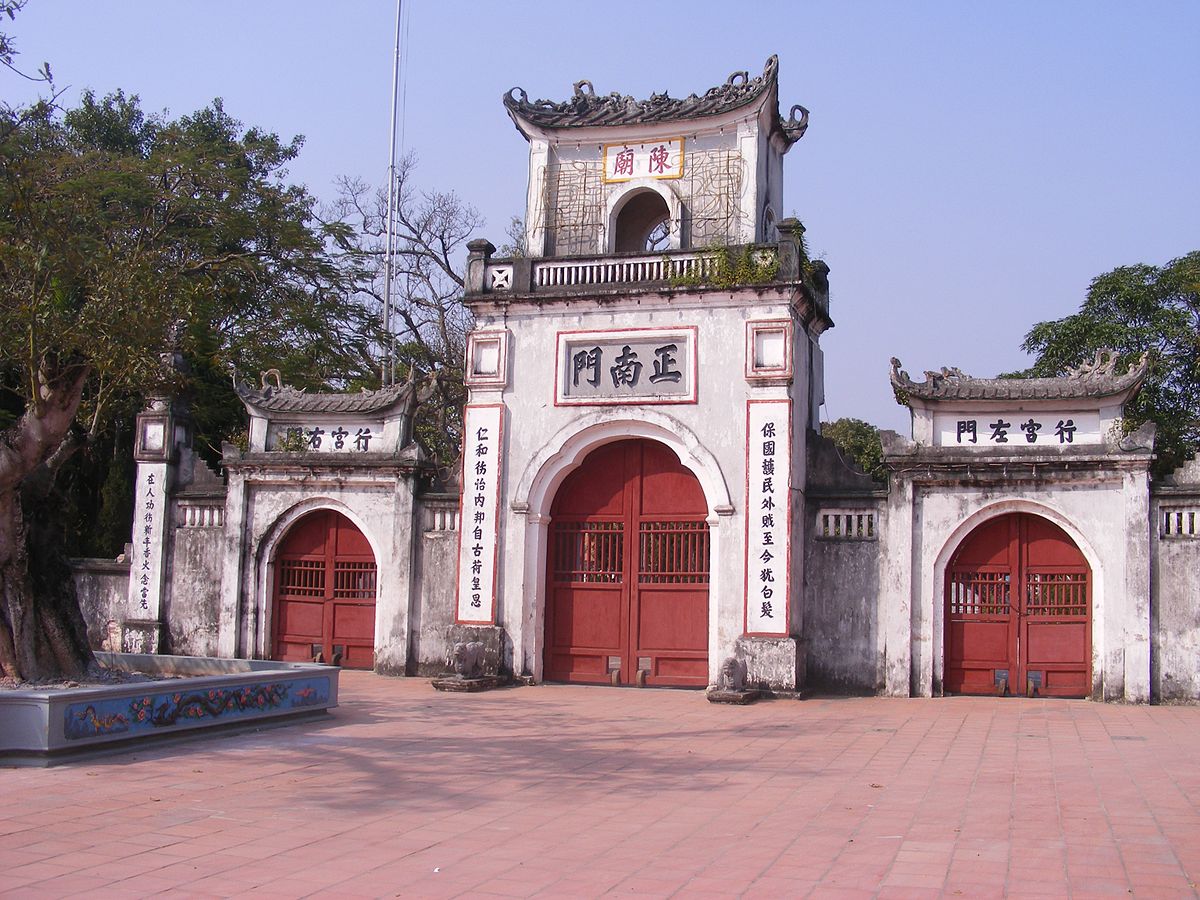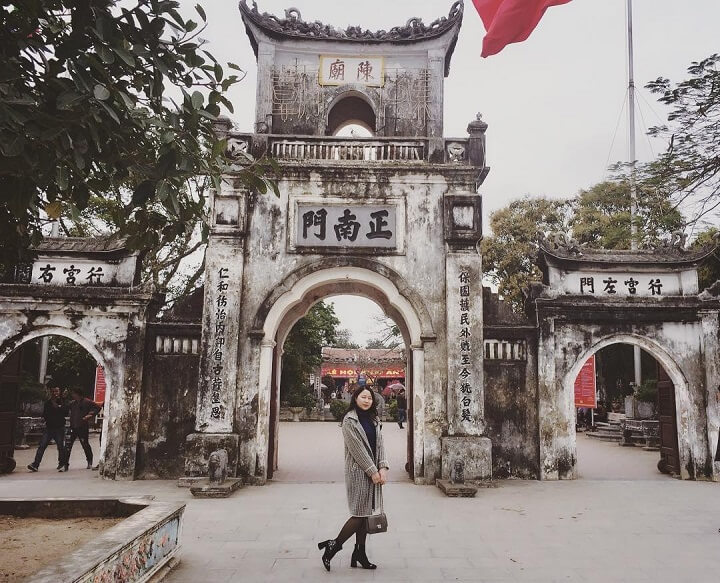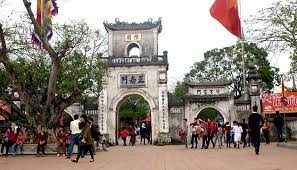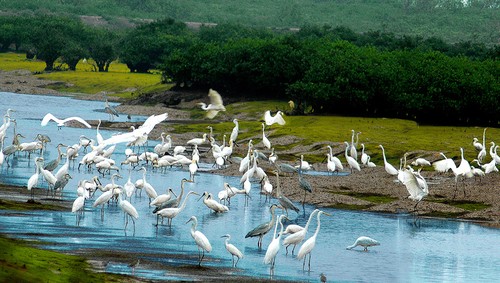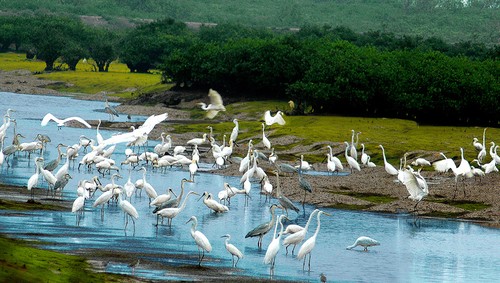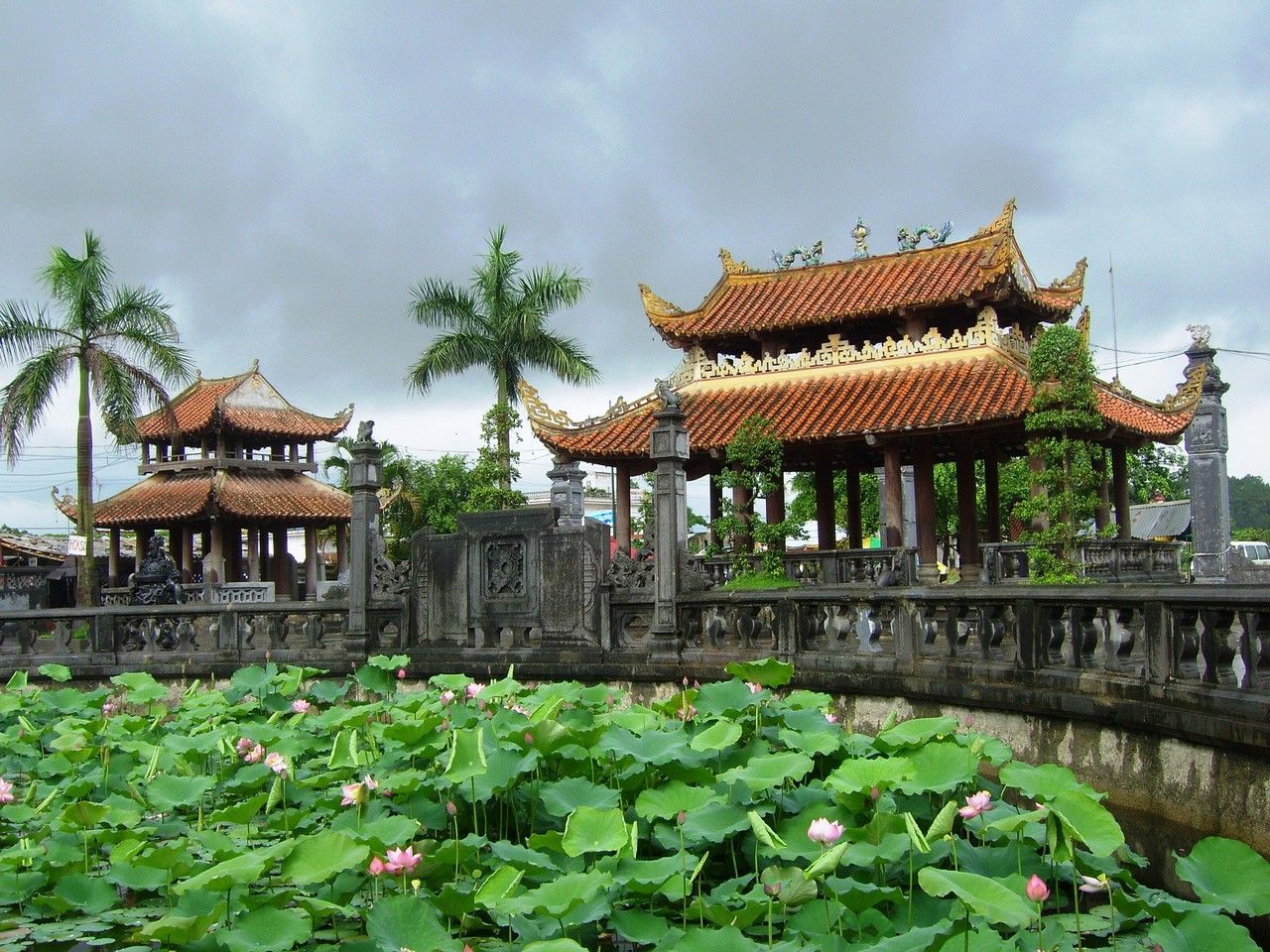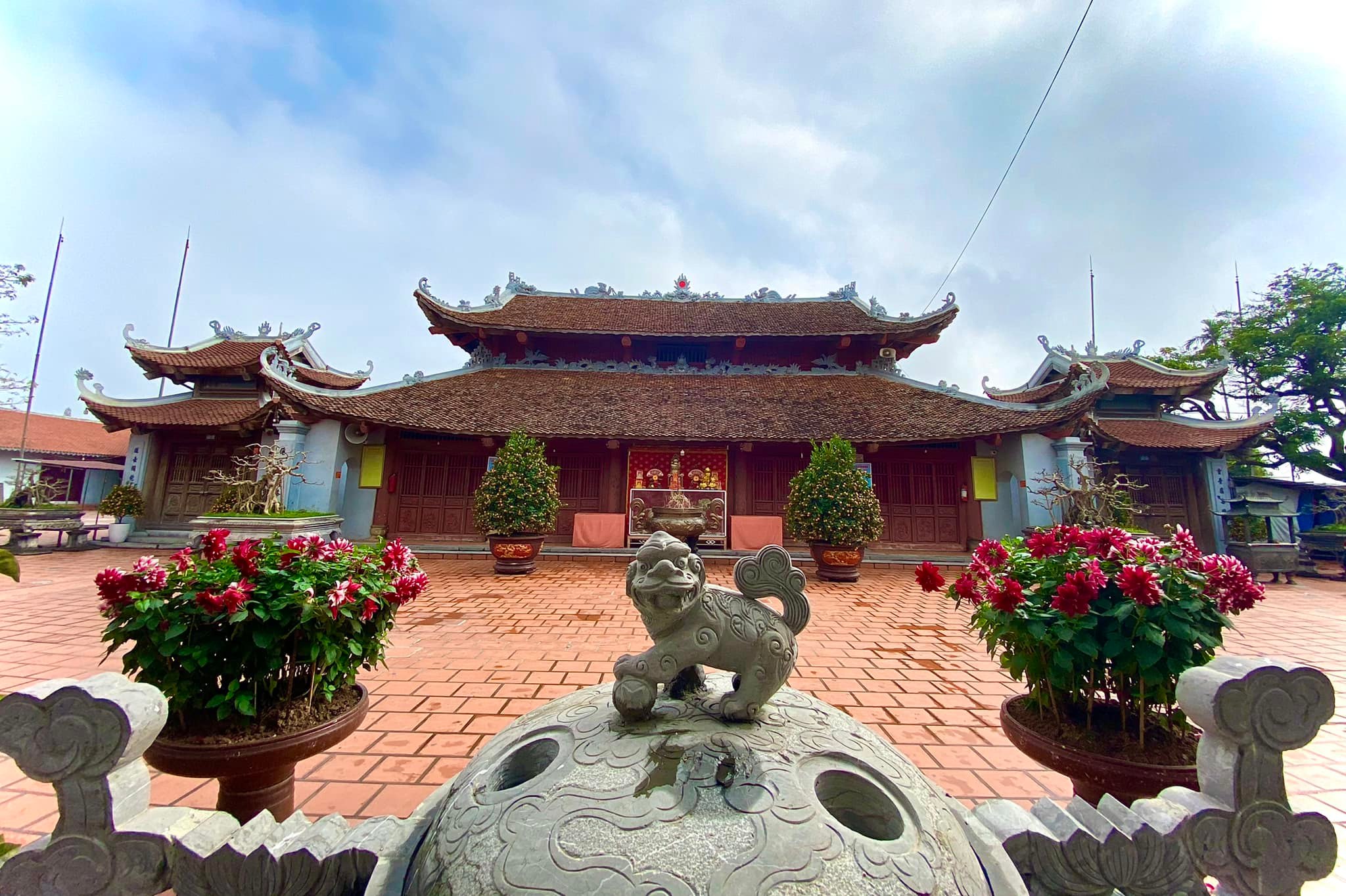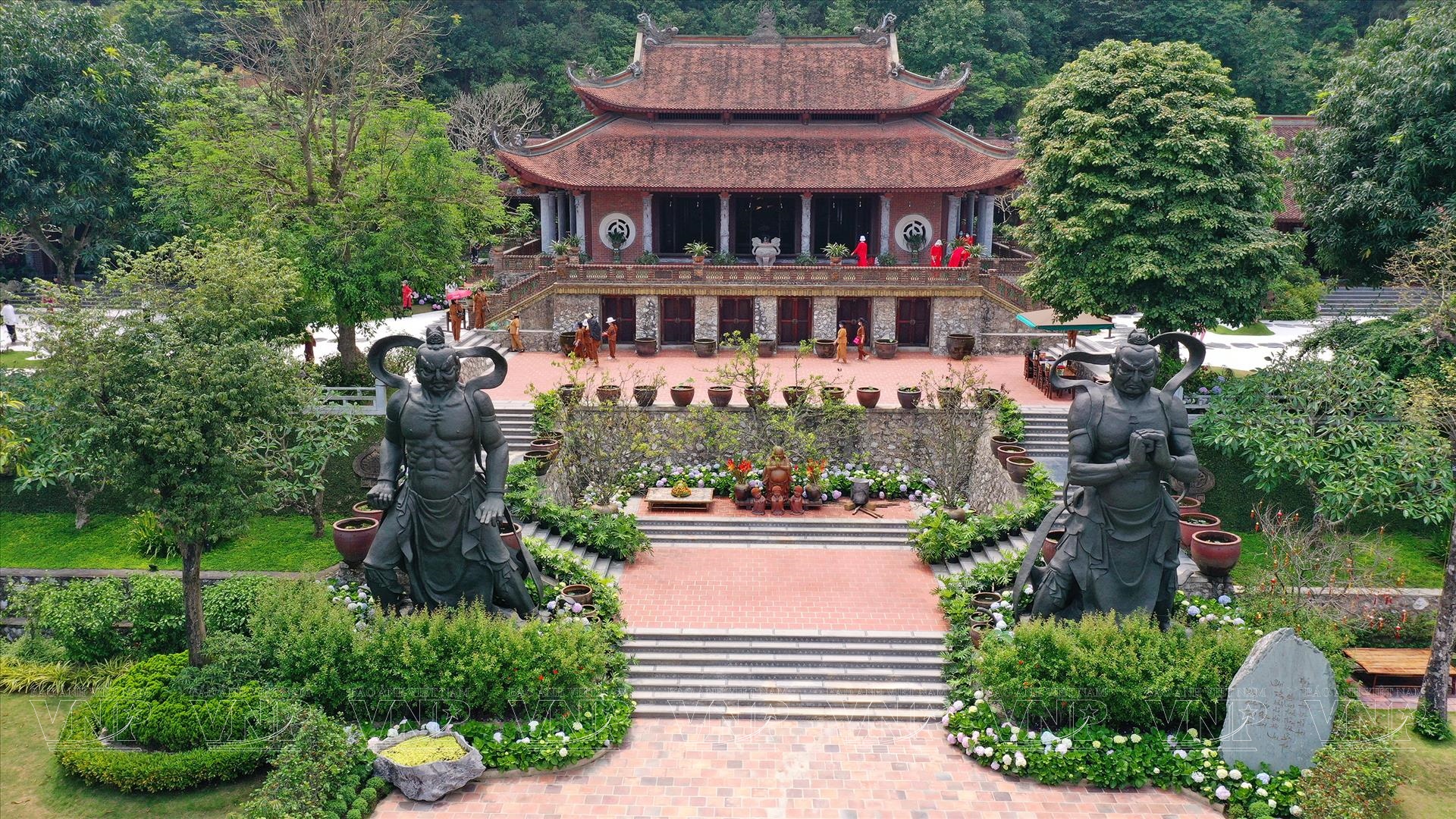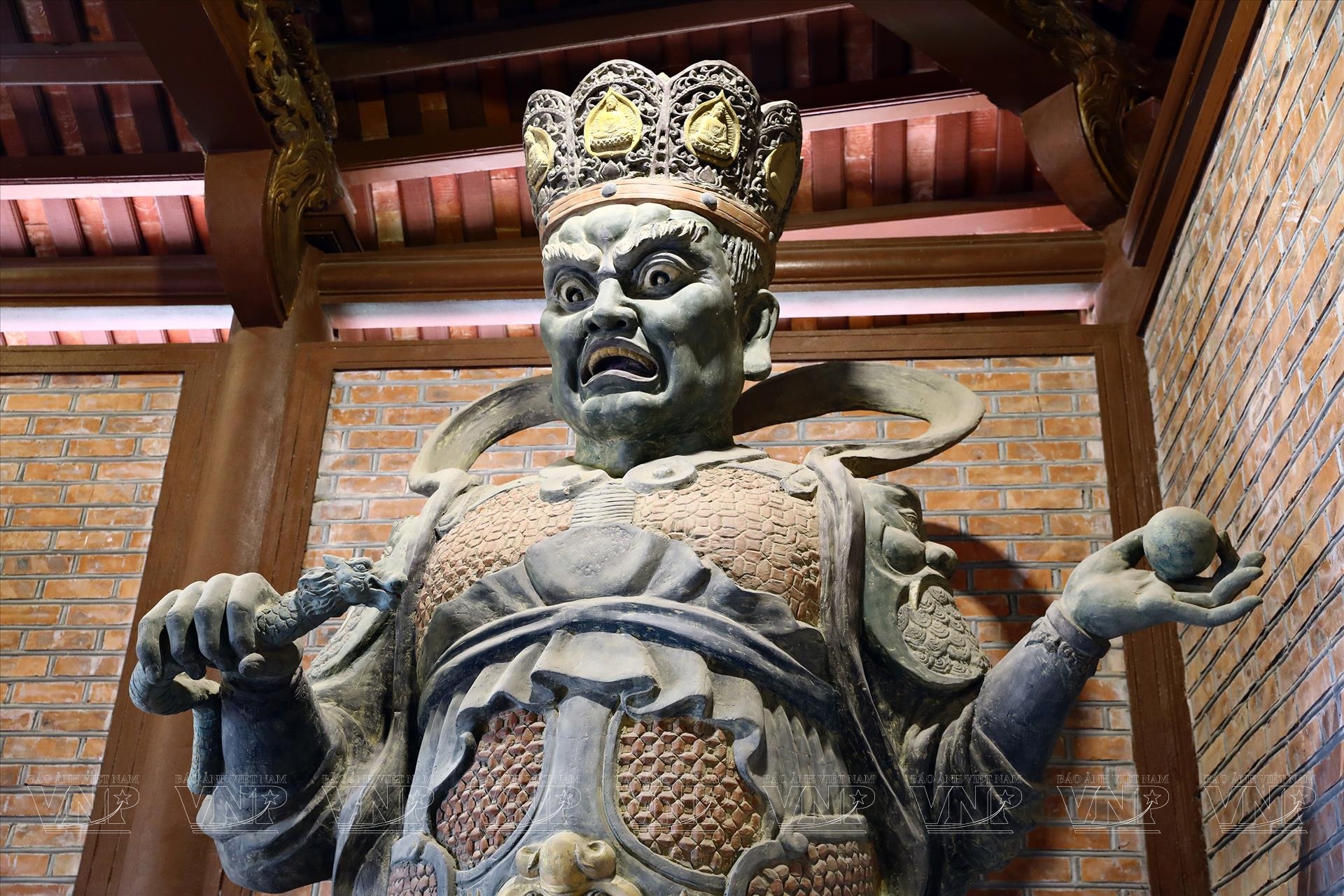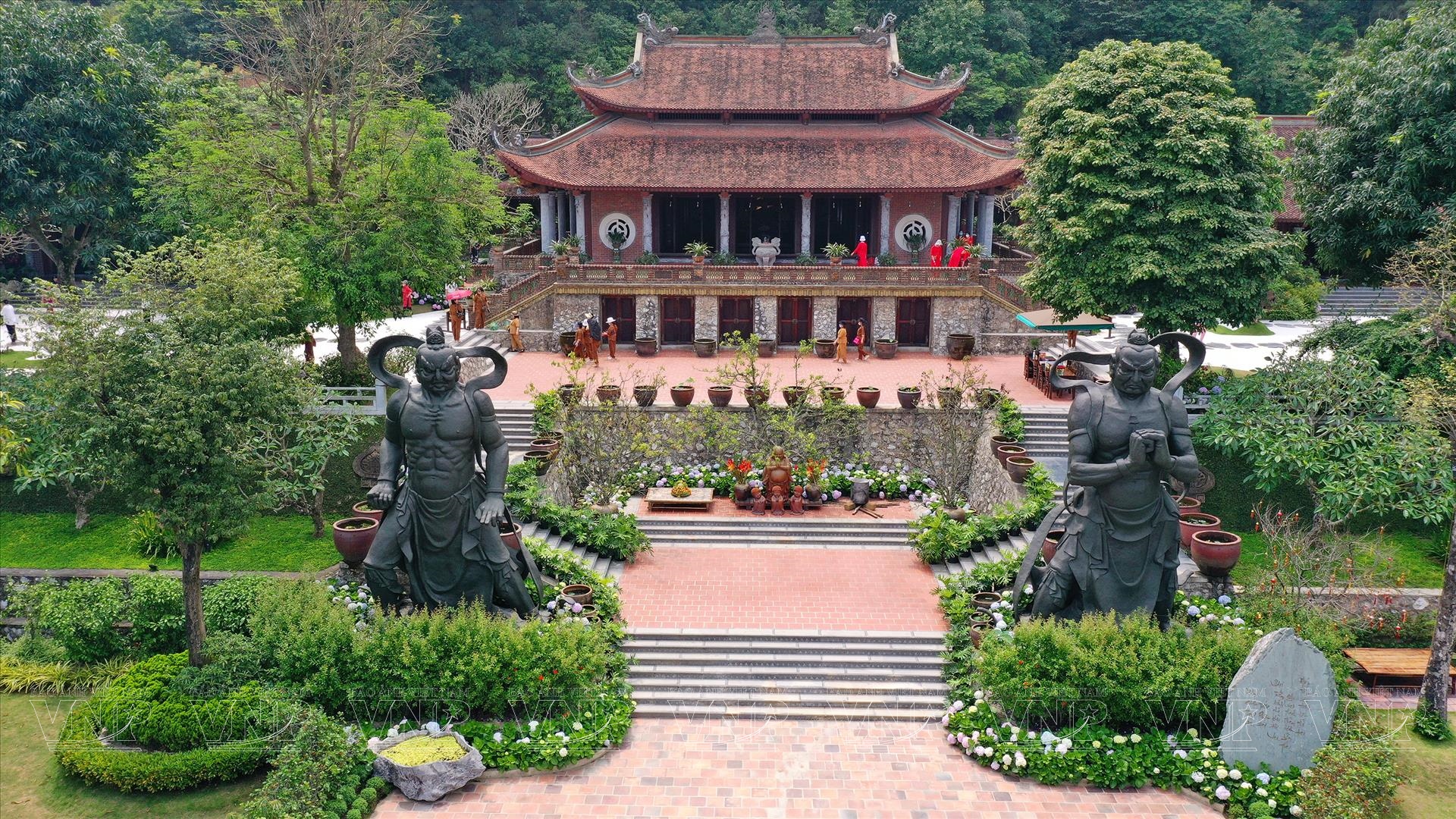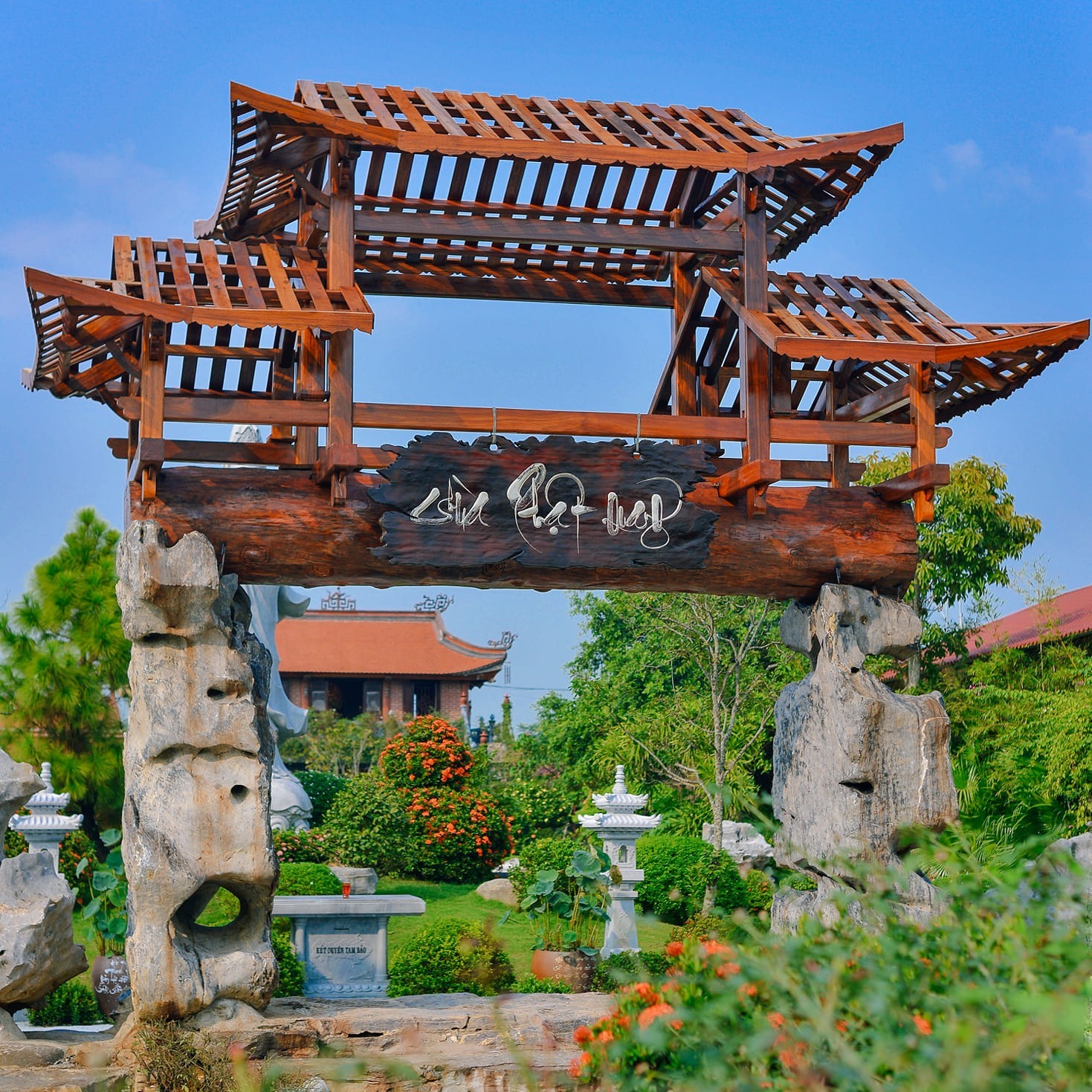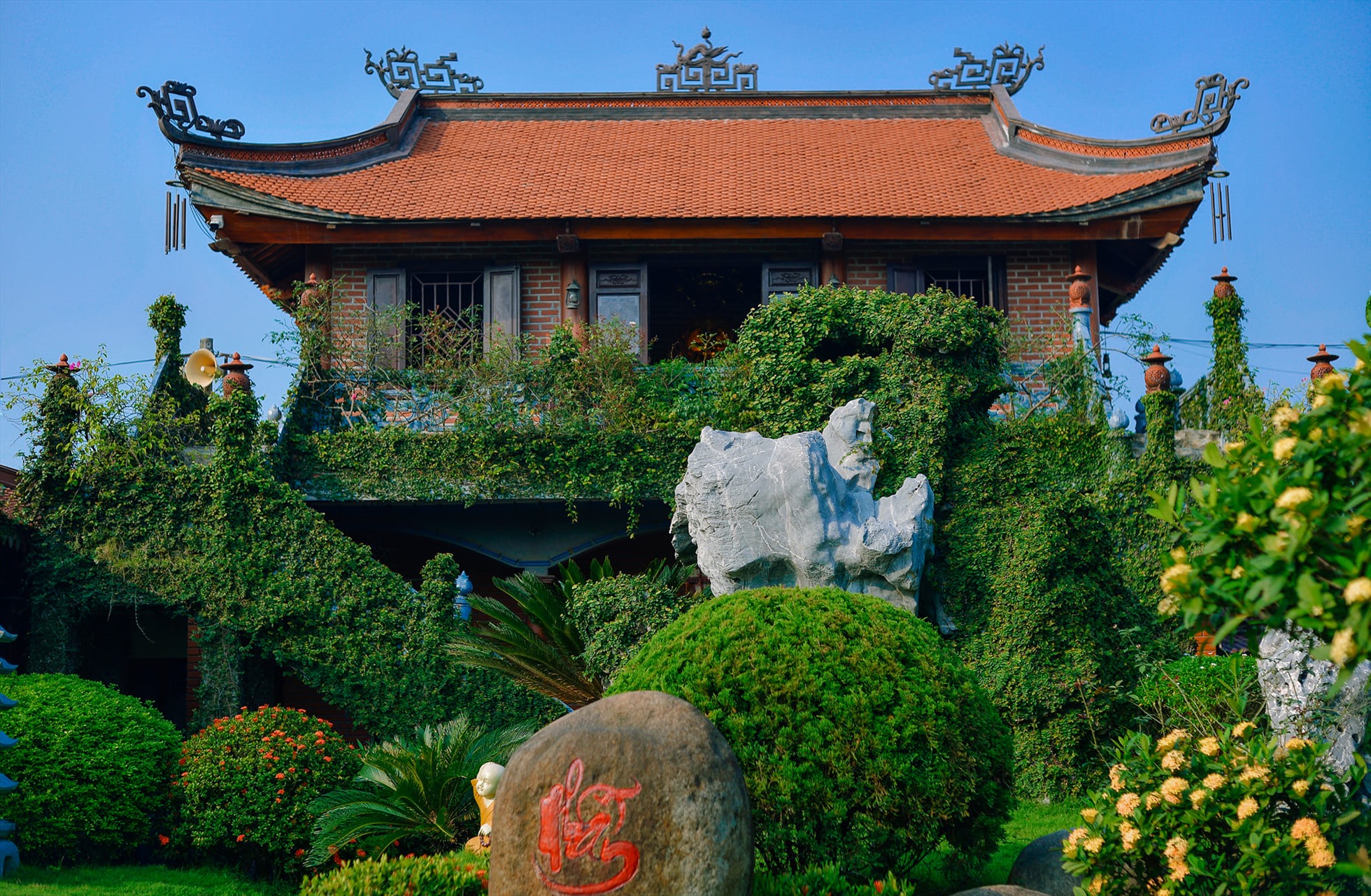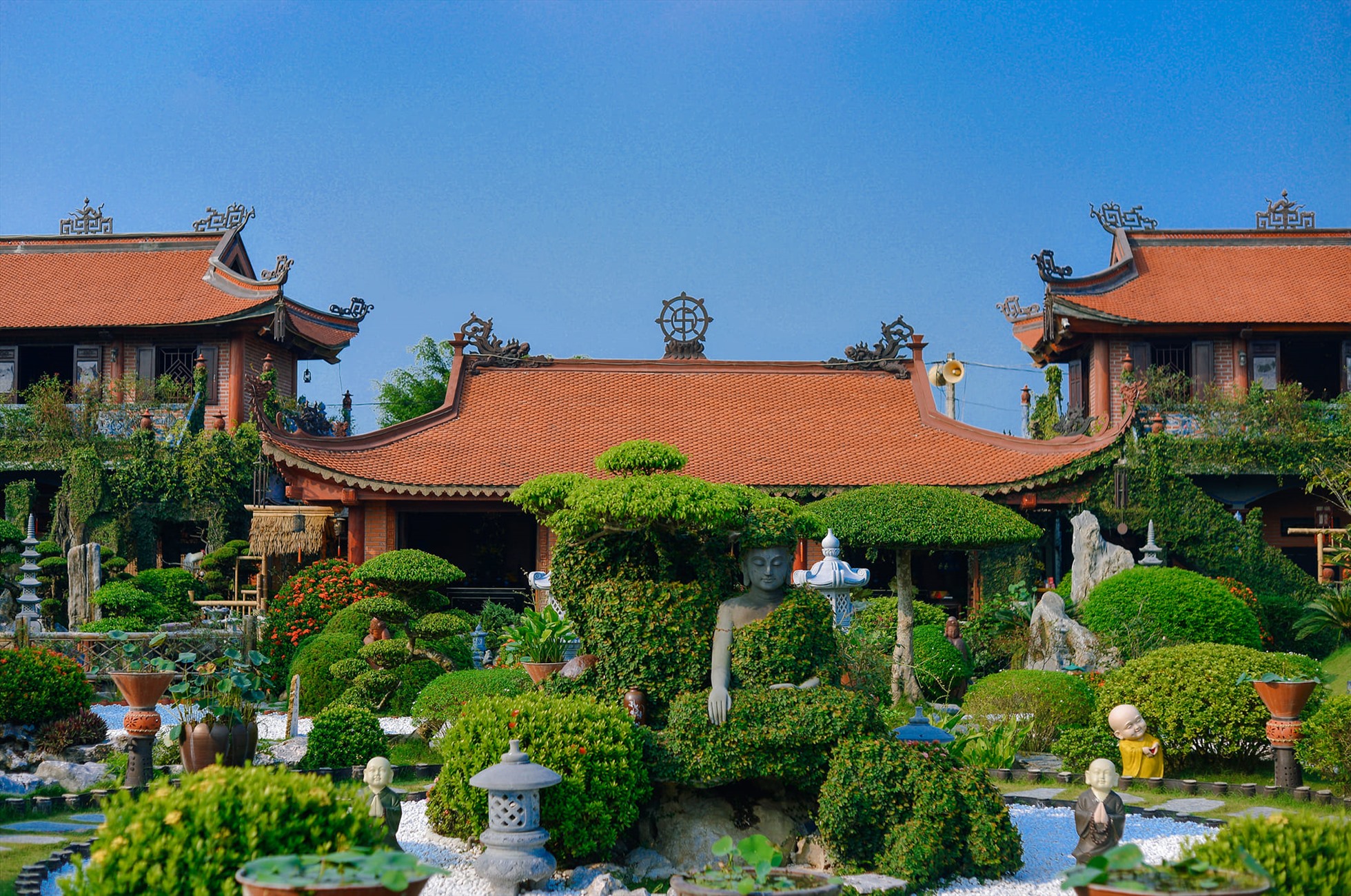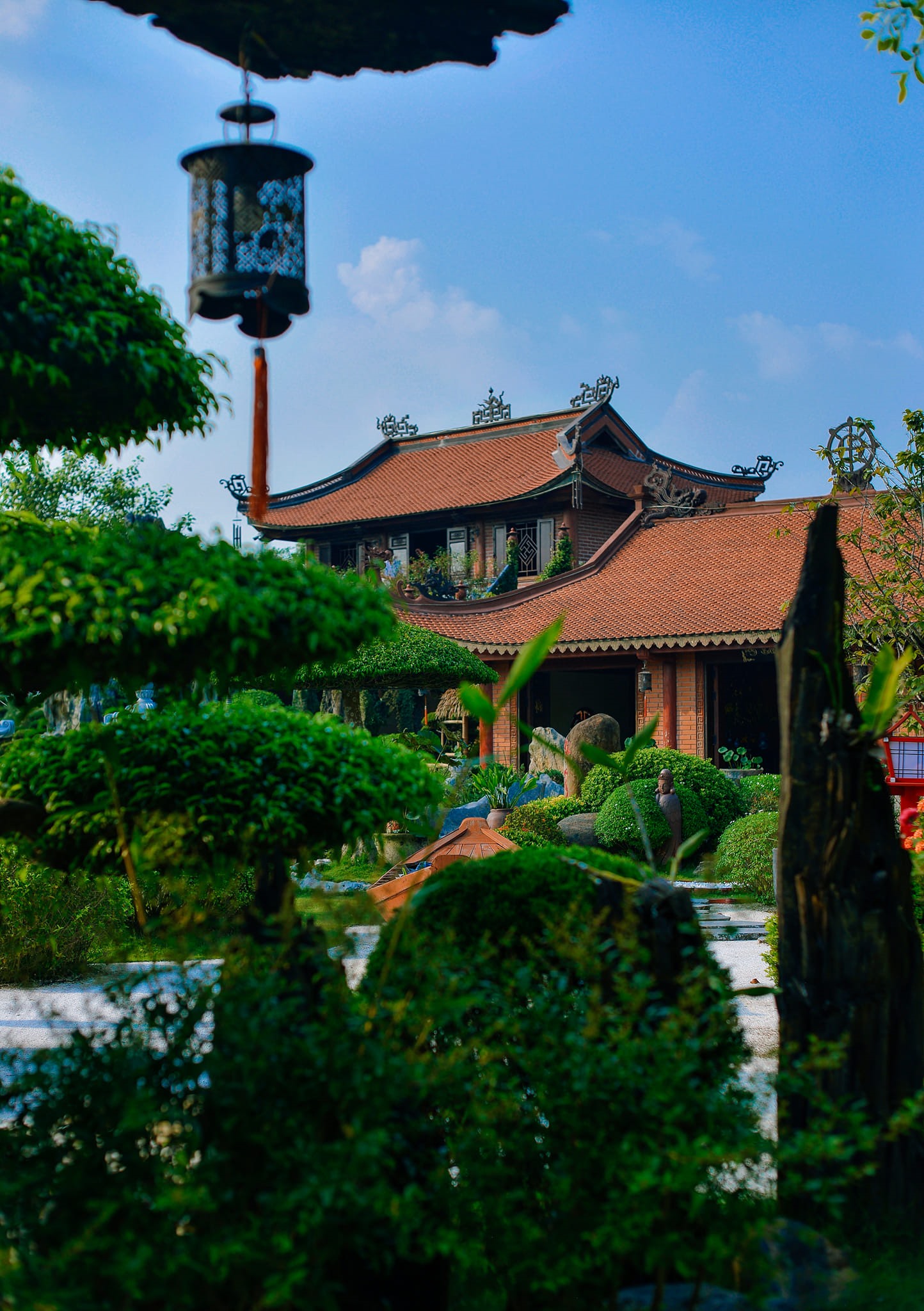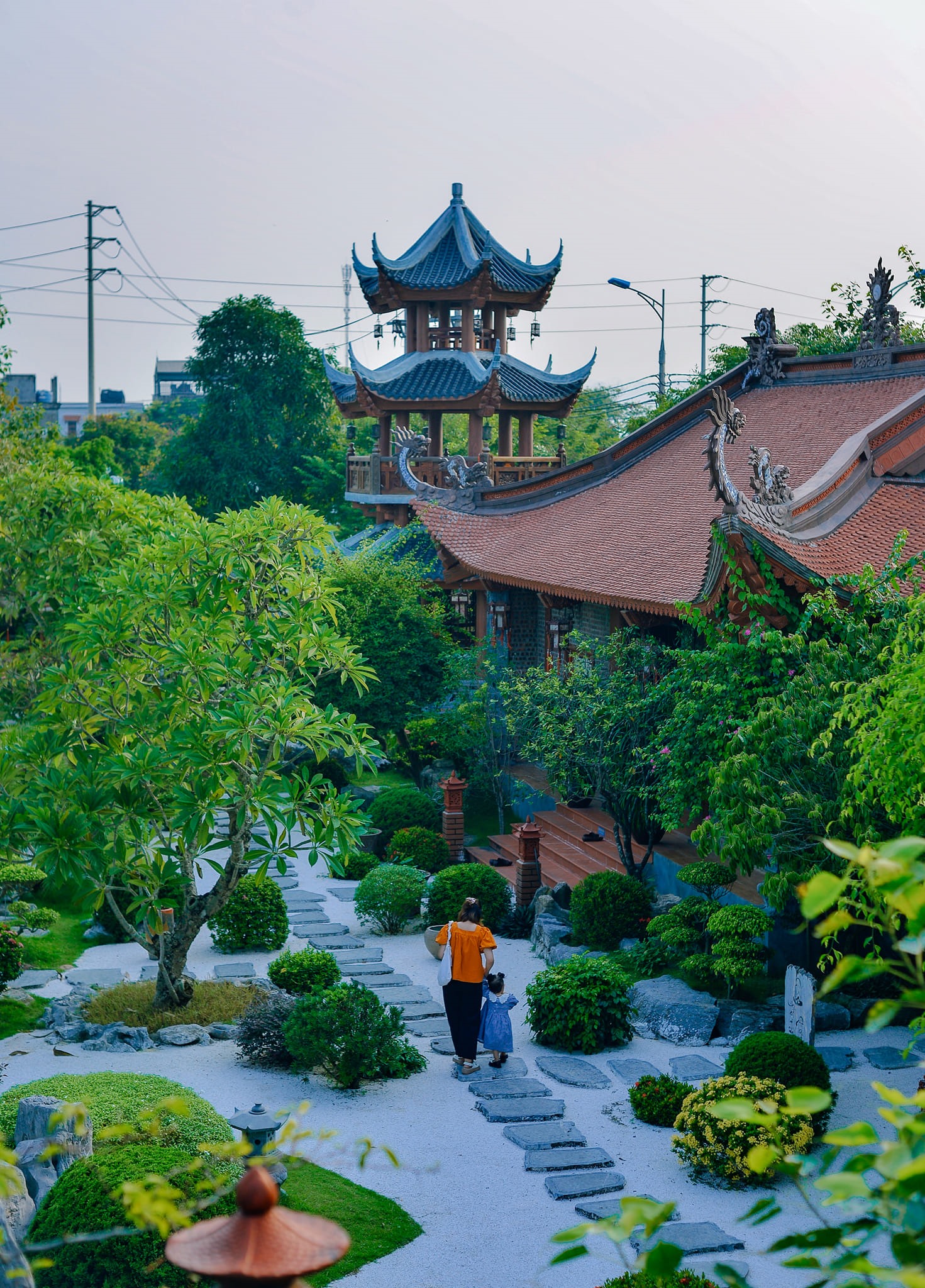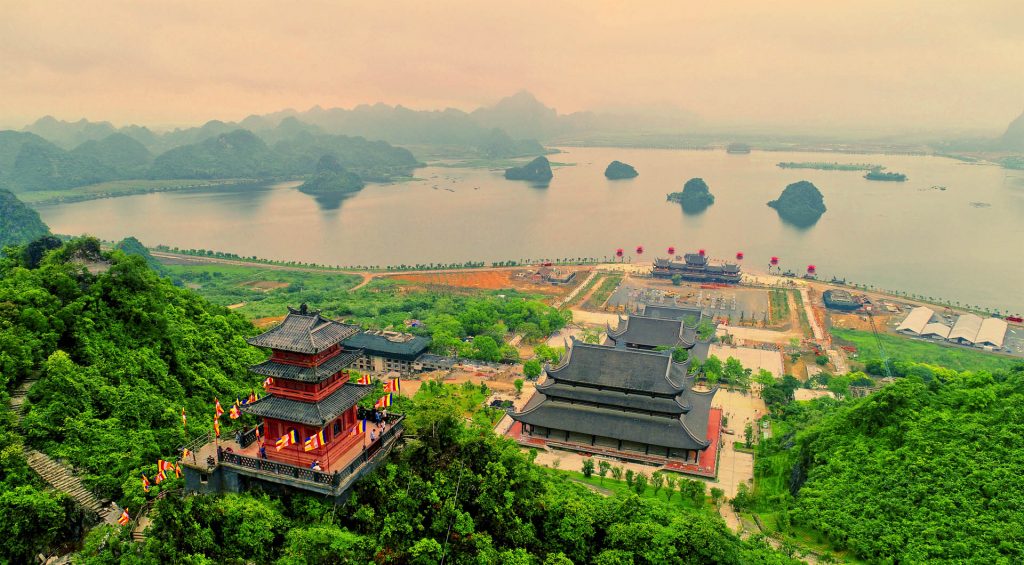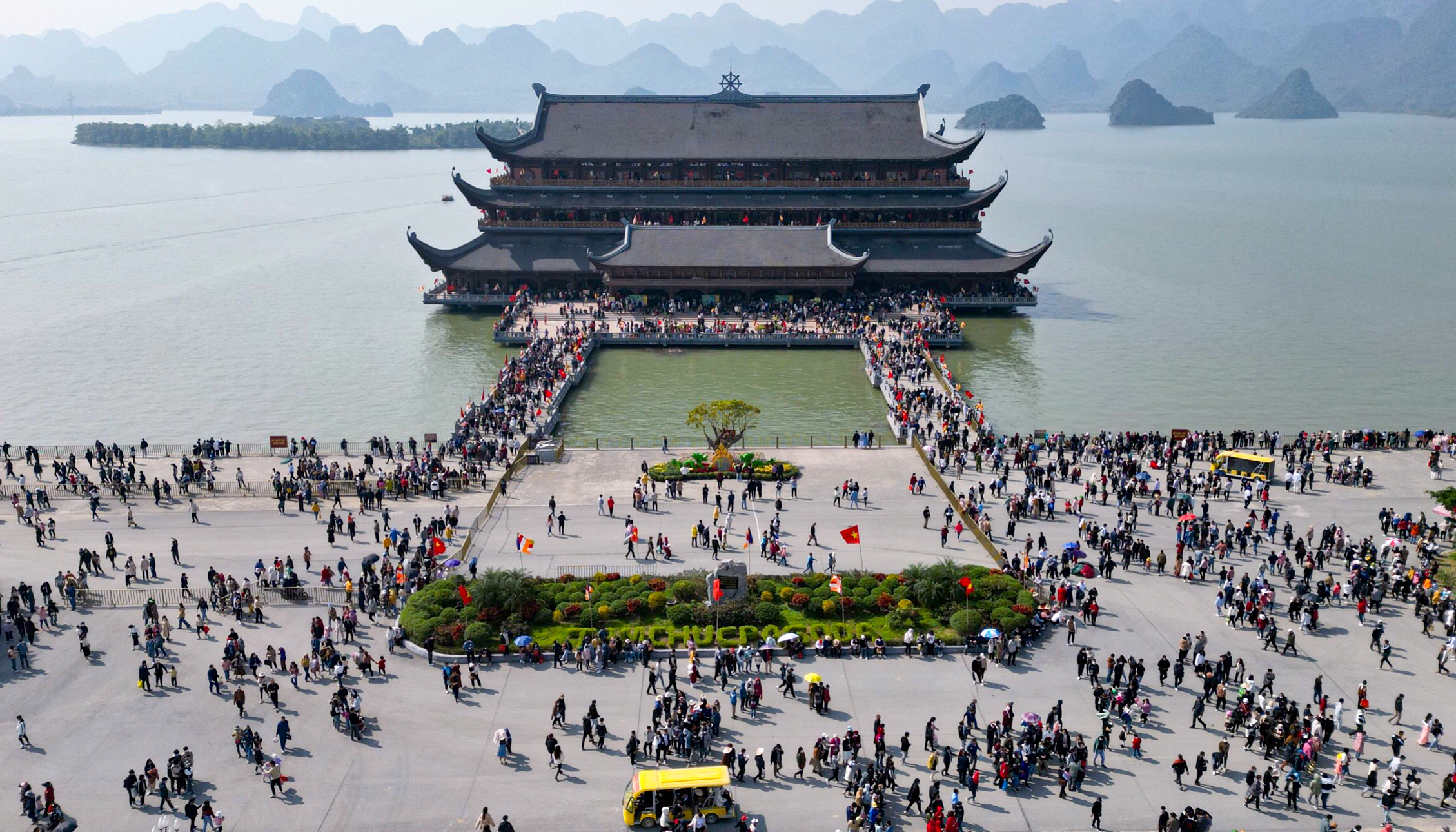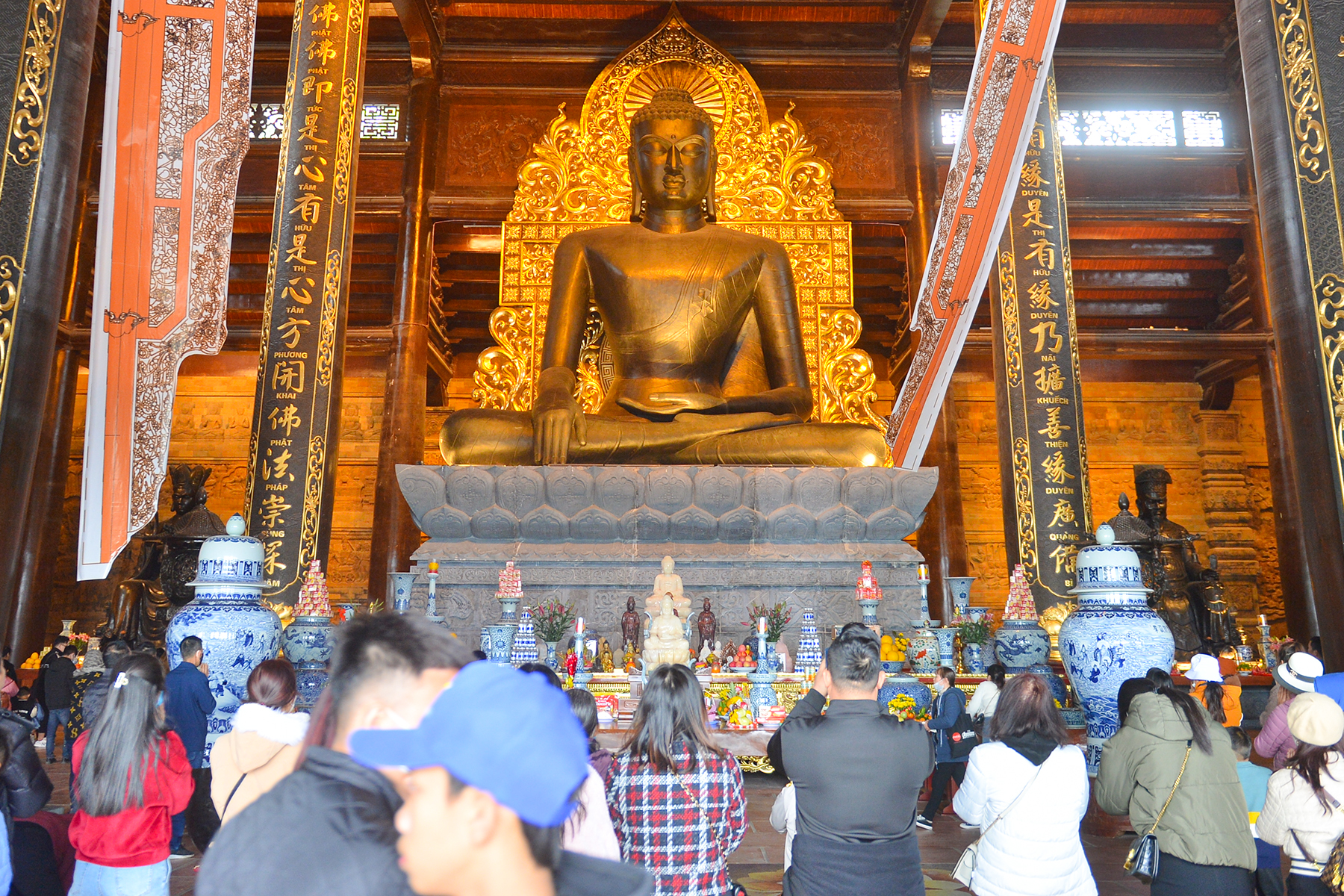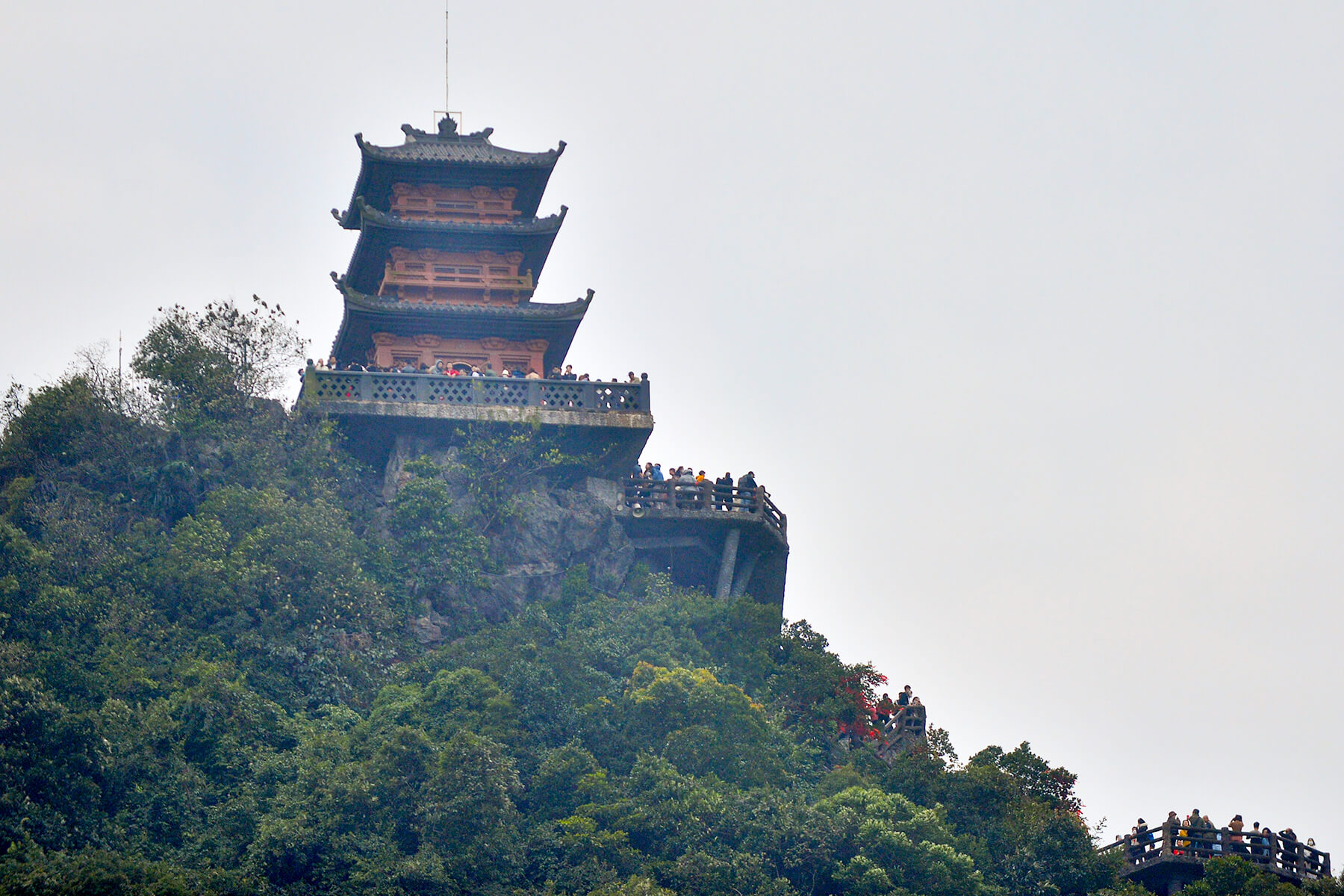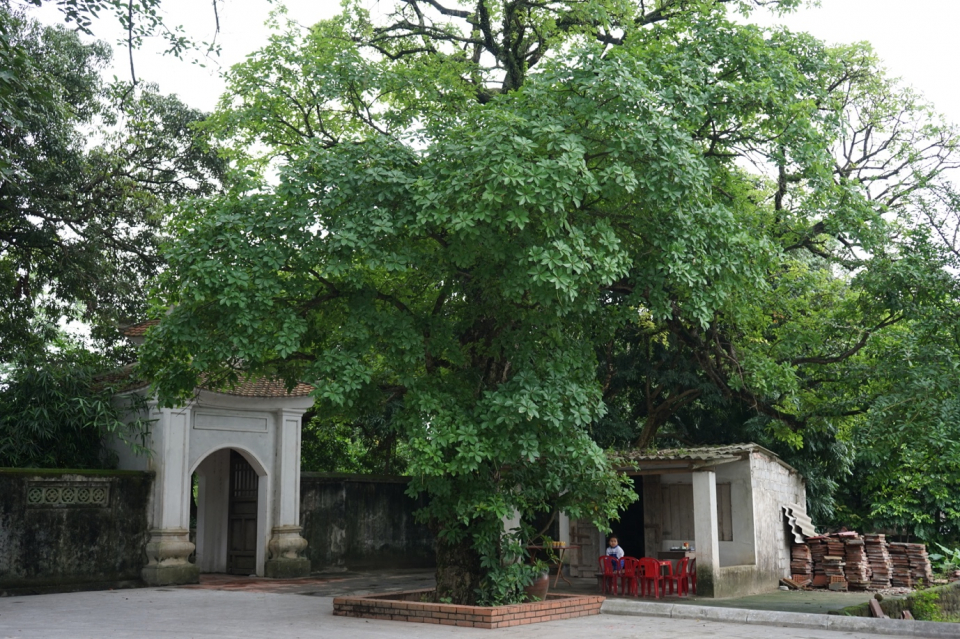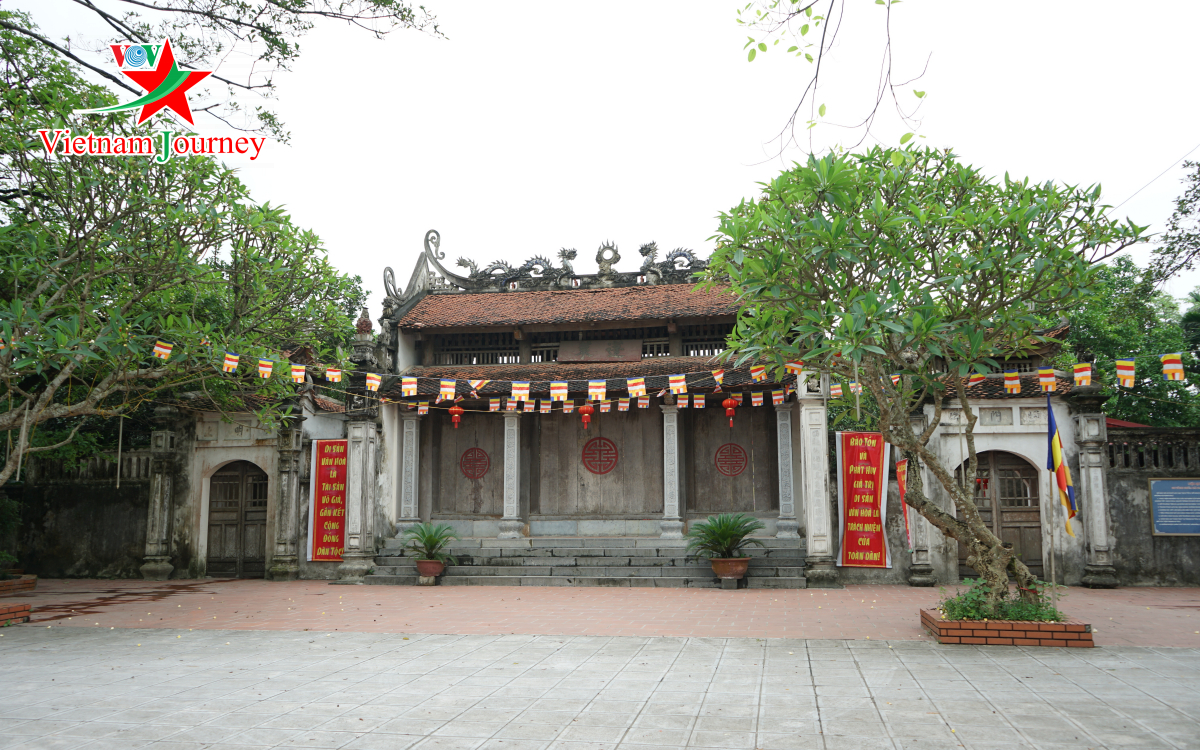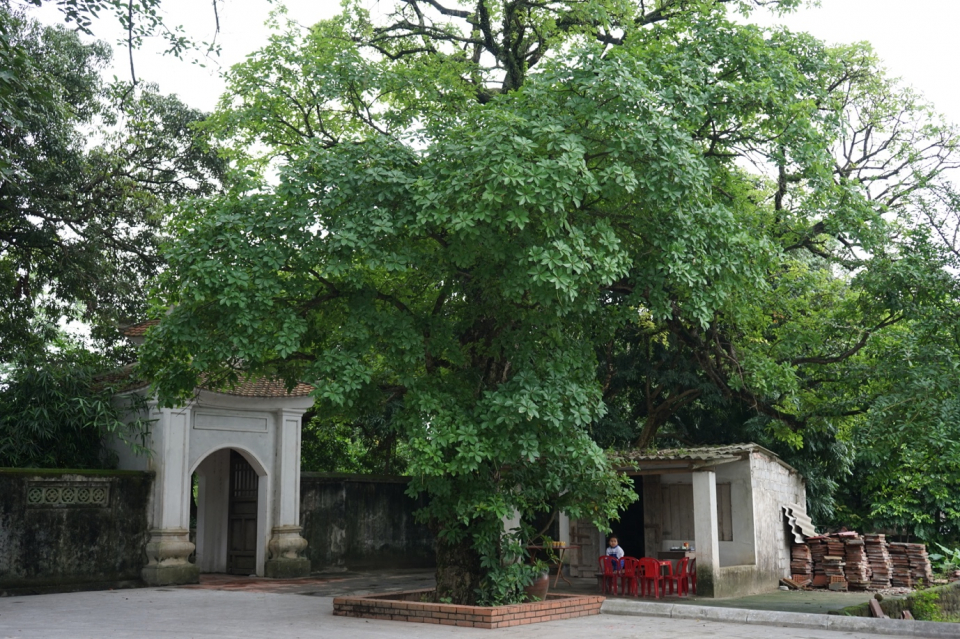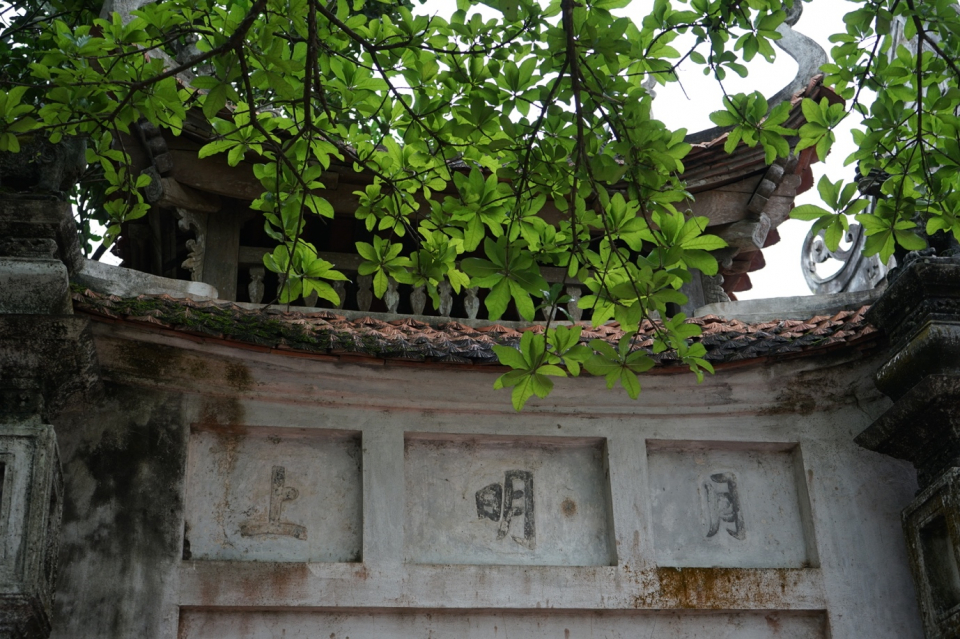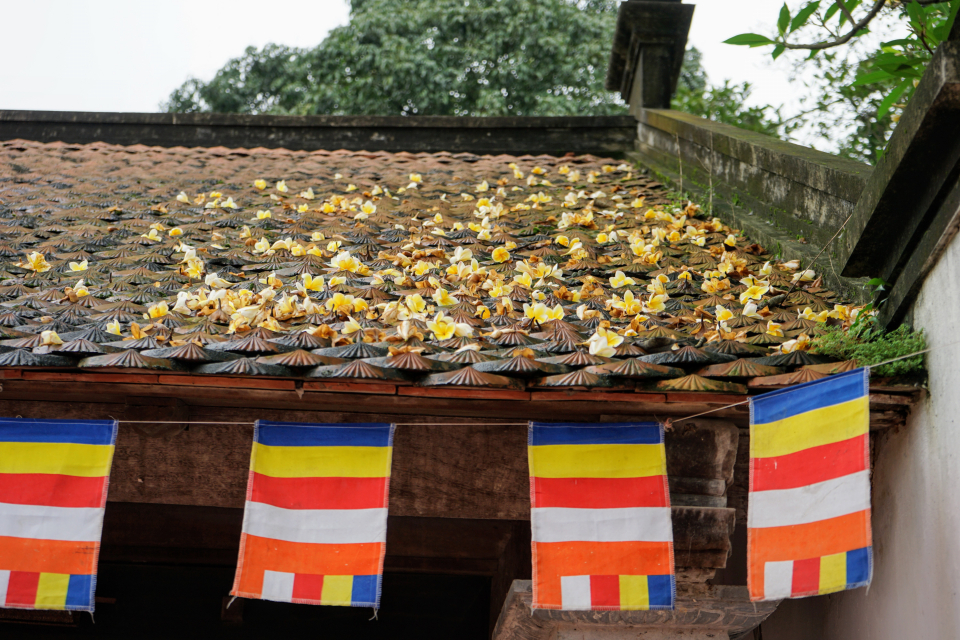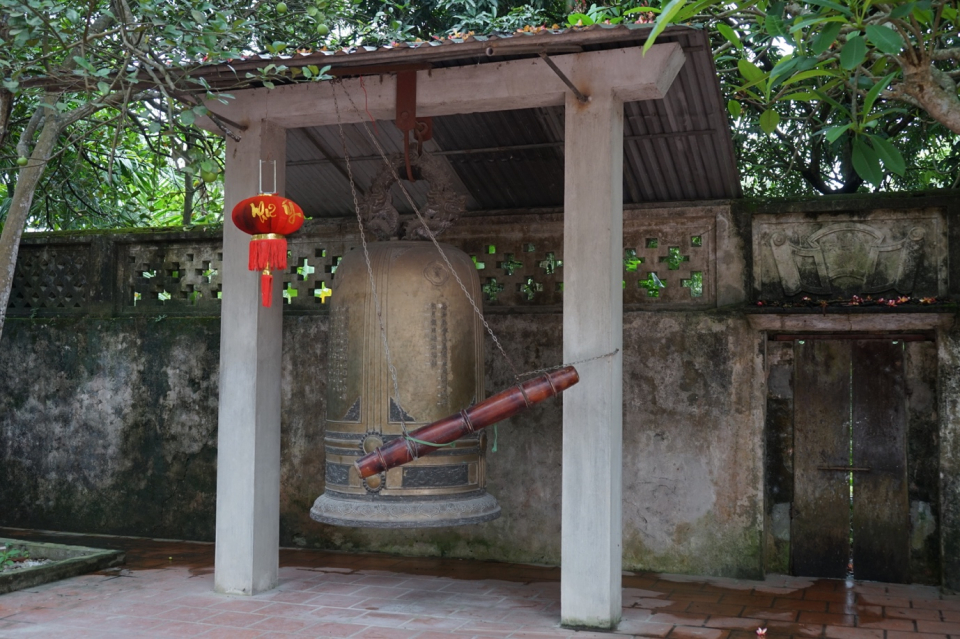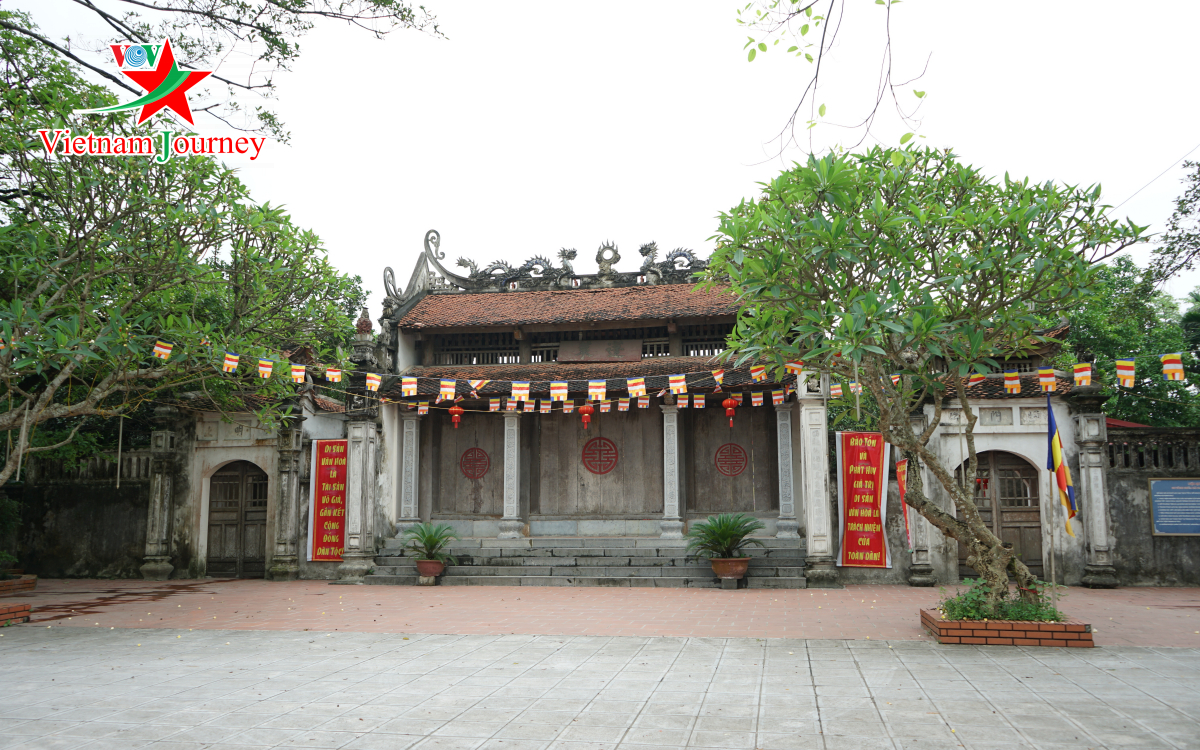Tourist destination
Na Hang tourist area
For a long time, Phat Diem Stone Cathedral has not only been a place for common spiritual and cultural activities of parishioners in the Kim Son area, but also a unique architectural work that attracts tourists from near and far to visit and admire the architecture. threshold. Because this is not only a harmonious and unique combination of Eastern and Western architectural art, but also a miracle that our ancestors left behind for future generations. Phat Diem Stone Church was built in the late 19th century by Phat Diem Parish Priest Peter Tran Luc (also known as Uncle Sau) - who was appointed as Phat Diem Parish Priest in 1865 after many years of research and completion of the outline. draw up plans and concentrate financial and material resources. The church is made of mainly stone and wood. On each stone and wooden slab, flowers bloom with exquisite carvings. Most notably, the art of stone sculpture is extremely soft and flexible, with pieces of stone only 3.5cm thick. The entire architectural complex consists of 9 rafters with 9 different stages of workers, so each rafters has a distinct cultural feature, reflecting the rich aesthetics of skilled craftsmen. Furthermore, the church was built entirely of stone without the need for a reinforced concrete core. The most difficult part of this project is the foundation treatment. Because Kim Son is inherently a muddy alluvial land, Parish Priest Peter Tran Luc had to exploit and transport thousands of tons of stone from a mountain in Thanh Hoa to prevent subsidence, including blocks of stone weighing up to 20 kg. ton. At the same time, Mr. Luc also exploited and transported hundreds of ironwood trees from Nghe An mountain forests to build the project. However, what makes cultural researchers and architects fascinated about the Phat Diem Cathedral complex is the harmonious combination of Eastern pagoda architecture with Western Gothic architecture. Mr. Sau is the one who designed and created the church with extremely new details. It could also be because he was not a Christian but a Buddhist, so in his design, he had a very ingenious combination of Western church architecture and curved roof architecture like that of a communal house. in Buddhism. The artistic quintessence at Phat Diem stone church also clearly demonstrates the harmony between stone carving art and Vietnamese wood carving art, such as the symbol of the cross (symbol of Catholicism) sitting on the lotus (symbol of the Catholic religion). Buddhist symbols), Buddhist "swastika" letters engraved on rosary flowers, stone and wood reliefs carved with images of Jesus and saints; In which the saints dressed in Vietnamese style look so vivid but close, as familiar as watching folk paintings; The stone pillar carved in the shape of a lotus flower represents the stages of "birth - old age - illness - death" according to Buddhist philosophy. Even more impressive is the Church of the Immaculate Heart of Mary, which is made entirely of stone, with a dazzling gilded sanctuary with many delicate and elaborate patterns and carvings but still creating a gentle feeling. peaceful because of its simple and familiar design according to the Eastern philosophy of "the sky is round, the earth is square". There is also a Bible verse carved into stone in early Vietnamese. It can be said that Phat Diem Stone Cathedral is an interference, a harmonious and sophisticated combination of Western church architecture and traditional Eastern architecture. Catholicism brings faith to people, but the architectural style and worship space with images of communal houses and pagodas are deeply ingrained in the subconscious of Asians in general and Vietnamese people in particular, creating peace and protection, this is also a symbol of the meeting between Catholicism and the religious traditions of the Vietnamese people from a very early age.
Ninh Binh
From January to December
4467 view
Na Hang tourist area
Hoa Lu ancient capital is a unique architectural complex in Ninh Binh province, recognized by UNESCO as one of the four core areas of the Trang An World Heritage complex. This place is also ranked by the government as a particularly important architectural complex and national historical relic that needs to be preserved. With a history of more than 1,000 years, this place has gone through many ups and downs of the nation, is a place to preserve historical relics through many eras as well as become a historical testament for our country. for thousands of years. However, even though it has gone through many ups and downs of time, Hoa Lu still retains its historical traces. Those are sturdy city walls, two majestic temples worshiping King Dinh Tien Hoang and King Le Dai Hanh, built to simulate the ancient capital of Hoa Lu. You can come to Hoa Lu at any time of the year. However, spring is the most beautiful time as well as many festivals are held, so this is the right time for you if you want to participate and experience the bustling, crowded atmosphere of these festivals. If you are someone who likes quiet and wants to enjoy the peaceful space of this place, you can choose to go on the remaining days. Since the past, Hoa Lu was a magnificent and magnificent imperial capital. The mountains and hills rise up around the capital's perimeter like a sturdy wall. The meandering Hoang Long River and the vast Nho Quan and Gia Vien fields are extremely convenient natural deep ditches. The entire historical and cultural relic site of Hoa Lu Ancient Capital, including the special protection zone, buffer zone and relics such as Thien Ton cave and Bai Dinh pagoda, are all located in the limestone mountain system in the area. Ninh Binh province, belonging to Truong Yen commune, Hoa Lu district, bordering Gia Vien and Hoa Lu districts. This place is about 100km south of Hanoi capital. Hoa Lu ancient capital is an architectural complex, and each architecture has its own characteristics, all creating the ancient and heroic look of ancient historical relics. The historical traces still remaining in the relic complex are very diverse and rich, including the architecture of city walls, royal citadels, caves, temples, tombs and many other types of valuable architectural works. history and high culture. Most notably, there are still two relics here: King Dinh temple and King Le temple. These are two monuments built around the 17th century with extremely elaborate and unique sculptures on wood and stone. The road to King Dinh temple leads visitors under the canopy of poinciana trees along the road. People call Hoa Lu the stone citadel and the temples of King Dinh and King Le also used many materials from stone. For example, when entering the temple yard, visitors will see a floor made of boulders and two flanking goats also carved from monolithic green stone. Entering the harem, visitors will see a statue worshiping King Dinh cast in bronze and placed on a green stone. King Le's temple is located 50m away from King Dinh's temple and has the same structure. 200 meters from King Le Temple, is Nhat Tru Pagoda, built during the reign of King Le Dai Hanh. In front of the temple door is a stone pillar, 4.16 meters high, eight-sided shape, engraved with the Shurangama Sutra made by the king to offer to the Buddha. . Located right next to it is a relic associated with the story of King Dinh Tien Hoang's third princess, who jumped into a well and committed suicide rather than follow her husband and betray her father. This temple worships that princess. On March 8 - March 10 every year, the traditional festival of the ancient capital of Hoa Lu takes place to honor the kings and national heroes who built and developed the capital of Hoa Lu and founded the Vietnamese dynasty. Dai Co Viet country in the 10th century. The festival of Hoa Lu ancient capital includes 2 parts: the ceremony and the festival. Besides the ceremony, the festival with traditional games such as boat racing, wrestling, cheo singing... takes place in an extremely jubilant and bustling atmosphere. When coming to this relic you need to note the following. Hoa Lu Ninh Binh is a spiritual tourist destination, so when coming here you need to dress politely and discreetly. When visiting the temples of King Dinh and King Le, you need to be gentle and orderly to maintain dignity as well as burn incense to show respect to the kings who have contributed to the country. It is necessary to follow the instructions of the monument management board or tour guide if traveling in a group. Must throw trash in the right place, do not litter indiscriminately. If you go on your own, you should look at the map in advance to make your discovery journey more convenient. You can directly chat with the elders in the temple relics management board to learn more deeply about the history, cultural values, architecture... of the relics. If you want to see with your own eyes and admire works of extremely historical value as well as architectural value, then come quickly to the ancient capital of Hoa Lu Ninh Binh - a work of great historical significance. that our ancestors' generation has worked hard to preserve and preserve until now. Let's come here to visit the ancient capital and relive the heroic moments of the nation's history.
Ninh Binh
January to December
5110 view
Na Hang tourist area
Tam Coc - Bich Dong is often known for its poetic, peaceful but no less beautiful scenes, captivating people's hearts - a place favored by the simile names "Nam Thien De Nhi Dong" or “Ha Long Bay on land.” It would be a mistake if you did not spend time traveling to Tam Coc - Bich Dong Ninh Binh, because this is a wonderful destination. It must be said that Tam Coc - Bich Dong is beautiful in every season, each season has its own beauty. But if you want to admire the lush green rice fields, full of vitality stretching across the winding stream like a soft silk strip, giving you a clear, fresh feeling, immersed in the flavor of rice. Earth, sky, rivers, and nature, the time after Tet in January and February is the appropriate time. And if you want to admire a beautiful picture of nature with mixed touches of the yellow color of ripe rice, blending with the green of the mountains and forests, and in the distance dotted with light boats floating extremely poetically, then Around the end of May, early June - when summer has arrived, it is a suitable opportunity to enjoy the beauty of Tam Coc - Bich Dong. One experience of traveling to Tam Coc - Bich Dong is that you can go and return in the same day, to save time - start early in the morning to breathe the morning air and have a complete trip because Tam Coc - Bich Dong is only about 110km from the center of Hanoi, so the luggage you bring with you only needs a few simple items such as a thin jacket in case the boat ride into the cave causes low temperatures and steam. causes a cold feeling. You can also bring an umbrella to use while boating on the river. In addition, it is best to wear flat shoes to facilitate comfortable movement and sightseeing. In addition, you can bring some snacks to eat when hungry. There are two options for you, one is to travel on your own by personal vehicle such as a car or motorbike to be proactive during your trip to Tam Coc - Bich Dong, or if you go in a large group and want to have If you have the opportunity to visit and walk, you can take a bus to Ninh Binh from Giap Bat and My Dinh bus stations. For a smooth trip, you should agree in advance on the vehicle, travel time, and respect punctuality. To admire and immerse yourself in the beauty of Tam Coc Bich Dong, you have only one choice: taking a boat. And if you are a photographer and want to preserve memorable moments and poetic scenes, please discuss and ask for help from boat drivers. Their experience and knowledge of the terrain will help you capture memorable photos. Another thing to note is that you should time it so that the trip is complete because the time on the boat when traveling to Tam Coc - Bich Dong also takes nearly 3 hours, avoid having to sit on the boat at noon when the sun is strong, or too late at night when the sun has already set. And it will certainly be great if you find an ideal seat to watch the sunset here, the harmonious sunset covering the fields and rivers like a story of attachment and sharing of nature's wealth. with the people here. Coming to Tam Coc - Bich Dong, you will definitely have wonderful and memorable moments of relaxation.
Ninh Binh
May to October
4743 view
Na Hang tourist area
Mentioning Nam Dinh means mentioning Thanh Nam land with a long history of culture and civilization. Mentioning Nam Dinh means mentioning the land of learning, which has trained many talents for the country. Nam Dinh has long been considered the second capital of Dai Viet after Thang Long capital because this is the birthplace of the Tran Dynasty. That's why the Tran Temple relic area has not only become a place to commemorate the Tran kings who contributed to protecting the country, but also a spiritual destination that attracts many tourists. To enter the Temple, you must go through the five-door gate. Through the gate is a lotus pond, with flowers blooming fragrantly throughout the entire area. The path to the temple is shaded by large old trees, creating shade for visitors to visit. Tran Temple relic area includes 3 main architectural works. In the middle behind the lake is Thien Truong Temple. On the right is Co Trach Temple and on the left is Trung Hoa Temple. Photo source: instagram vickyvan97 Every year, Tran Temple holds two major festivals that attract many visitors. The Tran Temple Festival is held from the 15th to the 20th of the eighth lunar month every year and the Tran Temple Opening Ceremony at dawn on January 15 has been registered as a national intangible cultural heritage. .
Ninh Binh
From January to December
4522 view
Na Hang tourist area
Xuan Thuy National Park is a coastal wetland conservation area in Giao Thuy district, Nam Dinh province. This is the first flooded forest in Southeast Asia to join the RAMSAR international convention. With an interesting and attractive ecological system, many rare bird species return to reside here, creating a beautiful and lively picture of a typical countryside right at the estuary along the Northern coast. The appropriate time to travel to Xuan Thuy National Park is from October - November to March - April of the following year, because at this time the number of birds increases dramatically, creating an extremely bustling atmosphere of thousands of individual birds. Migrating from the North to escape the cold. Besides, according to Xuan Thuy National Park travel experience, you can also visit in the summer months to enjoy the sea breeze and admire the brilliant scenery here. Traveling to the national park is also an opportunity for you to enjoy special Giao Thuy dishes such as: spring rolls, Giao Thuy spring rolls, Sa Chau fish sauce, jellyfish salad, mangrove honey... or other types of seafood. Fresh delicacies from the sea such as clams, oysters, shrimp, crab... Xuan Thuy national ecosystem is recognized by UNESCO as the core area of the world biosphere reserve in the interprovincial coastal area of the Red River Delta. This is considered a platform for international migratory birds with more than 200 species, including more than 50 species of water birds and 100 species of migratory birds. Therefore, Giao Thuy National Park will become an attractive eco-tourism area for domestic and foreign tourists when traveling to Nam Dinh. Besides visiting Xuan Thuy National Park, tourists return to the mainland and rest at hotels and motels. And if you want to have a memorable experience in your life, you should set up a sleeping tent in the pine forest next to the clam field so that you can wake up early in the morning to catch a wonderful sunrise. With over 200 species of birds and tens of thousands of individuals, Xuan Thuy National Park is truly a large bird station of the Red River Delta. Coming to Xuan Thuy National Park, you will discover new bird species, freely watch birds passionately foraging for food, flocks of storks flying above the green forest floor.
Ninh Binh
From January to December
4593 view
Na Hang tourist area
Phu Day architectural and artistic relics (including: Phu Tien Huong, Phu Van Cat, Mausoleum of Lieu Hanh) are located in the two villages of Tien Huong and Van Cat in Kim Thai commune, Vu Ban district, far from the city center. Nam Dinh street is about 15km southwest. This is a relic with typical historical, cultural and artistic architectural value that has been ranked nationally by the Ministry of Culture according to Decision No. 09-VH/QD dated February 21, 1975. Phu Day worships Holy Mother Lieu Hanh, the head deity in the belief system of Mother Goddess worship (Three Palaces, Four Palaces) of the Vietnamese people, and is also one of the "Four Immortals" of the Vietnamese temple. She was conferred with many titles by feudal dynasties from the Le to Nguyen dynasties as "Mother Nghi Thien Ha" (Mother of all peoples) with the following titles: Ma Vang Bodhisattva, Great King Che Thang Hoa Dieu. Most villages and urban areas in our country have temples, pagodas, and temples worshiping Mother Lieu Hanh, which is very solemn. Among them, Phu Day relic has long been considered the center of Mother Goddess worship (Three Palaces, Four Palaces) of Vietnamese people. Based on historical books, scientific research works and folk legends about the story of Saint Mother Lieu Hanh, the Phu Day relic was built on the homeland where the Mother was born for the second time. According to the content of the stele "Tien tu genealogy" (Jade genealogy records the work of Tien Huong temple), "Holy Mother's late Trach Linh Tu Bi Ky" (Stele recording the old foundation of the sacred temple of the Holy Mother) is currently kept. At the site, Phu Day (including Phu Tien Huong and Phu Van Cat) had the earliest construction history in the Later Le dynasty, the reigns of Duong Hoa (1642) and Canh Tri (1663-1671). The original project was just a small temple built by local people to worship and pay tribute to the merits of Saint Mother Lieu Hanh. Through historical periods, the government, people and tourists from all over have contributed money and efforts to restore and build Phu Day into a spacious and majestic architectural complex to worship the Mother Goddess as it is today. Tien Huong Palace was built on a campus of nearly 7,500 square meters, facing southwest. On the overall plan, the project consists of 19 buildings with 81 large and small rooms of different heights and heights, arranged symmetrically and harmoniously, forming an architectural plan of the "Inside the terrace, outside the country" style. Looking from the outside, first is a round well with the meaning "Gathering water to gather blessings", followed by 3 communal houses, a semicircular lake and the main building. On both sides of the main building are two bridges running all the way connecting the Co and Cau floors with the stele house and guest house. The main building has four worship palaces: first, second, third, fourth. The shrines all have frames made of ironwood, designed in the same way as each other, creating a space for worship that is wide on the outside and deep on the inside. Among the four worship palaces, the fourth palace is the project with the highest artistic value. Here, on the system of trusses, horizontal beams, vertical beams, and planks carrying architectural components, artisans meticulously machined and carved them with many vivid themes and motifs such as: four sacred animals. , four precious items, fish turning into dragons, dharma wheels, pairs of "five blessings" money, bats with the word "tho" in their mouths, Nghe chau, two peaches, lotus turtles... have artistic value during the Nguyen Dynasty, 19th century - XX. Phu Van Cat is located about 1km east of Phu Tien Huong, built on a land area of nearly 3600m2, facing Northwest. The project consists of 7 buildings with 30 large and small compartments, also designed similarly to Thien Huong Palace in the style of "Inside the terrace, outside the country". On the overall plan, looking from the outside, first is a semicircular lake, in the middle of the lake is a 3-compartment water pavilion built entirely of ironwood. Next is the Nghi Mon system (five gates) designed in the style of a 3-storey stack, 5 lofts and the main building. The main project is also designed to include 4 palaces: first, second, third, and fourth. The architectural and artistic value is most clearly shown on the wooden architectural structures of the fourth palace. Here, the artisans have put all their ingenuity and effort into carving extremely rich and diverse works of art with motifs of dragons, dragons flanking phoenixes dancing, mixed with groups of glasses playing with other animals. The turtle is hidden under the lotus pond... in the architectural and artistic style of the Later Le period, 17th - 18th centuries. Mausoleum of Lieu Hanh was built in 1938, on a high land area with an area of 1647m2. The mausoleum was built entirely of green stone, including many square walls. In the middle of the walls there is a door made up of two pillars, with a pink stone lotus placed on top of the pillar. In the middle of the mausoleum is an octagonal tomb, each side is 1.3m wide. The overall mausoleum has 60 pillars corresponding to 60 lotus buds, looking like a nasturtium pond from afar. Phu Day architectural work, since its inception, has undergone many restorations, embellishments and expansions but still preserves intact the architectural values bearing the artistic imprint of the Le - Nguyen dynasties. . With reasonable and scientific calculation of scale, architectural structure, and ingenious combination and use of construction materials, our ancestors created extremely unique and perfect works of art. . All three relics of Tien Huong Palace, Van Cat Palace and Lieu Hanh Mausoleum, not only have typical historical, cultural and scientific values but also have aesthetic, architectural and artistic values. In addition to being located in a charming landscape, these relics all have a majestic scale, symmetrical and harmonious structure, along with unique artistic value through rich sculptural themes. diversity. All of these elements have become an important nucleus constituting an architectural complex, a famous "super temple" not only of Nam Dinh, but also typical of the whole country. In addition, the system of relics, antiques and worship objects such as epitaphs, ordinations, parallel sentences, great characters... along with the legend of Holy Mother Lieu Hanh are rich and valuable sources of information to help scholars. Scientific research in many fields explains and identifies the great value of these relics to the nation's cultural heritage system through the ages.
Ninh Binh
From January to December
4162 view
Na Hang tourist area
No need to go far, right in Ha Nam there is a pure and beautiful temple loved by many people, which is Ksitigarbha Phi Lai Tu Pagoda. This pagoda also has other names such as Phi Lai Dia Tang Pagoda or the Nom name Dung Pagoda, with a history of more than 1000 years old. On both sides there are mountains shaped like a left dragon, a right white tiger and many ancient objects of sacred historical value, bearing the mark of the history of Vietnamese Buddhism. The pagoda's location is right on a small hill, behind a green pine forest and in Ninh Trung village. The space inside is extremely spacious and flat with a spacious entrance path. Those who come here for the first time will be somewhat surprised when the yard leading to the temple is covered with white gravel instead of red bricks like many other places. According to local people, Dung Pagoda was initially built around the 11th century with more than 100 compartments. There was a time when King Tran Nghe Tong chose this place as a hiding place and King Tu Duc also came to pray. After many years of being known as a place of worship, the pagoda's architecture gradually eroded over time, surrounding it with trees, making people forget it. In December 2015, the pagoda was received, renovated, rebuilt and renamed by Venerable Thich Minh Quang. The name of the temple refers to Ksitigarbha Bodhisattva who always comes or may never come to this place. The place that transformed into Buddha's land is the place where Ksitigarbha does not return. Ksitigarbha Phi Lai Tu Pagoda has a charming mountain-like landscape and a small lotus pond on the premises. The whole ensemble seems to be hidden in a magnificent forest. Right in front of the Ancestral Hall are 12 circles drawn on the gravel floor symbolizing 12 human causes and conditions. Right in those 12 circles, there is a sign "Kho hai (sea of suffering) because it is the sea, so please go ashore" is placed, carrying a gentle message reminding you to go on those smooth rocks, don't step on the pebbles. . Moon pebbles also have a meditative significance. That's also the reason why when walking around the yard, just looking at the pristine pebbles, people's hearts become peaceful. The image of Ksitigarbha statue exuding kindness and majesty is placed at Ksitigarbha Phi Lai Tu Pagoda with the main colors brown, yellow and white. On the campus you can also find gardens of fruits, herbs, wild vegetables... well taken care of by the people and monks. At the foot of the mountain, Dia Tang Phi Lai Tu Pagoda also built a mushroom growing house of about 20 square meters to provide clean food when cooking vegetarian hot pot or making vegetarian shrimp paste. For those of you who enjoy reading books, especially books that nourish the soul, Ksitigarbha Phi Lai Tu Pagoda is a paradise on earth with the number of books covering the walls. In addition, when you need to breathe fresh air, you can also admire the orchid pots located behind the Ancestral Church or go to the Zen garden to enjoy tea, lie in a hammock, or sit on a stone bench to watch the pagoda from above. Visiting here at the beginning of the year, you will see the image of Ksitigarbha Phi Lai Tu Pagoda decorated with many bright fresh flowers to celebrate the traditional New Year. In addition, from September to October of the lunar calendar, the pagoda will also recreate the countryside market scene with many familiar items to impress visitors. June - July is the time when Ksitigarbha Phi Lai Tu Pagoda organizes summer retreats that many Buddhist families love to enroll in. More specifically, on the 30th day of the 7th lunar month, the pagoda will hold the Vu Lan ceremony, the extremely solemn ceremony of Ksitigarbha Bodhisattva. Another ideal time to visit is the Mid-Autumn Festival on the 15th of the 8th lunar month when we can enjoy the full moon and enjoy the open space around.
Ninh Binh
From January to December
4175 view
Na Hang tourist area
Through many ups and downs, Phat Quang Pagoda, an ancient pagoda nearly a hundred years old in Du Nhan village, has experienced many difficulties. Initially it was just a small temple serving the spiritual needs of the local community. However, due to its long history, many buildings began to deteriorate and become damaged. Faced with this situation, Abbot Venerable Thich Thien An decided to restore the entire temple space. The restoration of Phat Quang Pagoda officially began in 2015 with many impressive architectural works such as fish pond, lecture hall, tea house, rockery, Patriarch's house, Tam Bao... on an area of more than 6,000 m2. The brilliant new look of Phat Quang Pagoda is not only the result of restoration but also the dedicated contribution and support of many monks, nuns and Buddhists. Venerable Thich Thien An, with calligraphy, paintings, and landscape decoration of the pagoda, creates a unique and impressive artistic space that makes visitors amazed. Phat Quang Pagoda is an interesting destination with exquisite architecture, rockery, fish pond, and massive stone tables and chairs. The pagoda's airy space is characterized by Japanese design with attention to every small detail, from bonsai to calligraphy on stone. Exploring this temple, visitors will feel peace, forgetting all worries and pressures of life. Tourists not only enjoy tea and flowers, but also have the opportunity to listen to monks preach. The pagoda is open to visitors and is willing to answer any questions about the history and meaning of each landscape within the pagoda grounds. Not only admiring and sightseeing, tourists also have the opportunity to enjoy attractive specialties of Ha Nam. Delicious Dishes Like Banh Chung of Dam Village, Braised Fish of Vu Dai Village, Banh Cuon Phu Ly will enrich your trip
Ninh Binh
From January to December
3725 view
Na Hang tourist area
Tam Chuc Pagoda belongs to the new Tam Tam Tourism Complex was formed in Ha Nam. Tam Chuc Pagoda is also known as the largest temple in the world with the landscape system and many rare treasures. Please join VNTRIP to visit the special things of this monumental temple. Tam Chuc Pagoda is located in Ba Sao town, Kha Phong commune, Kim Bang district, in Ha Nam province. From here, the center of Hanoi takes about 60km. This temple has a very special location that can be considered as a bridge connecting Huong pagoda and Bai Dinh pagoda in Ninh Binh. Located in a very favorable position when behind the temple is That Tinh and the front is Luc Nhac Lake, there are 6 islands in the lake that is said to symbolize 6 bells that are given by heaven. Currently, the transportation system connects Hanoi and Ha Nam is very convenient. Tam Chuc Pagoda is about 30km from Bai Dinh pagoda and 4.5km from Huong Pagoda to create a "golden triangle" population in spiritual tourism activities. The entire project of Tam Chuc resort complex is up to 5000 hectares, including many landscapes such as large lakes, rocky mountains, valleys to create magnificent and magnificent. Tam Chuc pagoda project is still in the process of construction and it is estimated that it takes another 30 years to complete this entire population. Tam Chuc Pagoda was built on the background of the ancient temple before, but according to archaeologists, this temple was over 1000 years ago. Over time and many historical events in this place only save ancient traces such as stone pillars, rocks, and many artifacts buried for thousands of years. Tam Chuc Pagoda has been rebuilt with 12,000 stone paintings depicting the legend of the Buddha, these works are carved by Indonesian Muslims with volcanic rocks to Vietnam. The outstanding works in this population can be mentioned: Ngoc pagoda, Tam The Palace, the French Master, the Gate of the Gate, the Tam Quan Gate, the International Meeting Room. Dinh Tam Chuc is a place to worship the queen of the Dinh dynasty named Duong Thi Nguyet. According to history books, Dinh Bo Linh was previously in the fight to defeat the 12 warlords that came here to recruit Ma until winning the battle and ascending the throne, the emperor sent the order to build the communal house here. Tam Chuc Pagoda Pagoda Pagoda deserves an attractive destination for Buddhists around the world to pilgrimage as well as domestic and foreign tourists to enjoy, worship lucky and peaceful prayers is the occasion of the months after the Lunar New Year. The temple is the perfect combination of the sacred ancient features where the thousand -year -old monument and the majestic and immense natural scenery. Tam Chuc Pagoda is currently and in the future will certainly be an attractive destination and are expected to create a driving force for socio -economic breakthrough for Ha Nam province.
Ninh Binh
From January to December
4465 view
Na Hang tourist area
Ba Danh Pagoda is located close to Ngoc Mountain and surrounded on three sides by the Day River. The outside of the pagoda is adjacent to the walking road, the three-entrance gate of the pagoda is near the river bank, so the three-entrance gate is five steps high and the two ends are closed. The three-door pagoda has three compartments, two floors, the upper floor has two layers of roof, roofed with male tiles, around the wooden floor are railings and convenient bars, this floor is used as a bell tower, the lower three compartments have wooden doors. lim. Outside the door are two bronze pillars, on the top of the three-door gate is a pair of flanking dragons. On both sides of the main gate is a small gate with eight roofs and a semicircular curving door. On weekdays, guests enter and exit through the small door, only when there is a ceremony at the temple does the main door open. Ba Danh Pagoda worships Buddha, in addition to Buddha, there are also statues of Thai Thuong Lao Quan, statues of Nam Tao, Bac Dau and worshiping the Four Palaces belief (Phap Van, Phap Vu, Phap Dien, Phap Phong). In particular, the pagoda worships the goddess Phap Vu, the goddess of wind. According to legend, the sacred goddess Phap Vu oversees the control of rain and wind, bringing favorable weather for good harvests and helping people's lives to be prosperous, so the pagoda is called Notre Dame de Danh village, or Pagoda for short. Mrs. Danh. In the central space of the pagoda is a statue of Ba Danh in a meditating position on a shiny black throne with a kind, gentle, feminine and close face. The harmony between the statue and the throne creates the appeal of sculpture art in the Northern Delta. Almost all of the temple's architectural and carving art is concentrated in the worship hall - the place for daily ceremonies. The pavilion has five ironwood compartments, gabled ends and two dragons embossed on it. Observing from the middle of the brick yard, visitors will see a system of embossed statues of "four dragons flanking the moon" on the roof of the street. All four dragons, from their designs to their bodies, are curvy, their eyes, antennae, claws, and fins are very lively, flexible, but also very fierce, looking like they are playing with each other, flying in the vast space. The dragon here carries the colors of the Nguyen Dynasty. At the beginning of the two corridors and adjacent to the worship house are two tall, majestic pillars. On each column are embossed images of four sacred animals: dragon, lyre, tortoise, and phoenix in a symmetrical, harmonious, and balanced position. Every line shows the talent of ancient artisans. Although beautiful and ancient, Ba Danh Pagoda is known for its desolation and desolation. There have been many theories to explain this, but the most convincing is that the pagoda is very sacred, if passersby or people coming to worship, if they laugh, talk loudly, or disrespect even a single sentence, they will be punished. Therefore, pilgrims visit the temple less and less. In addition, the pagoda is located far from residential areas, with few people living around it. Three sides of the pagoda are rivers, forests, and trees, so very few people come to the pagoda, except during major Buddhist festivals. The above reasons have made the already deserted temple even more deserted. Today, the pagoda has been invested and rebuilt to be quite spacious and spacious, with more visitors coming to the pagoda. Therefore, the old saying has now been changed to: "Once upon a time it was quiet and deserted/ Now it is as busy as Ba Danh pagoda." Ba Danh Pagoda currently preserves many rare antiques and ancient books, especially Buddha statues, Bodhisattva statues, great pagodas, stone carvings, parallel sentences and incense sticks...
Ninh Binh
From January to December
4741 view
